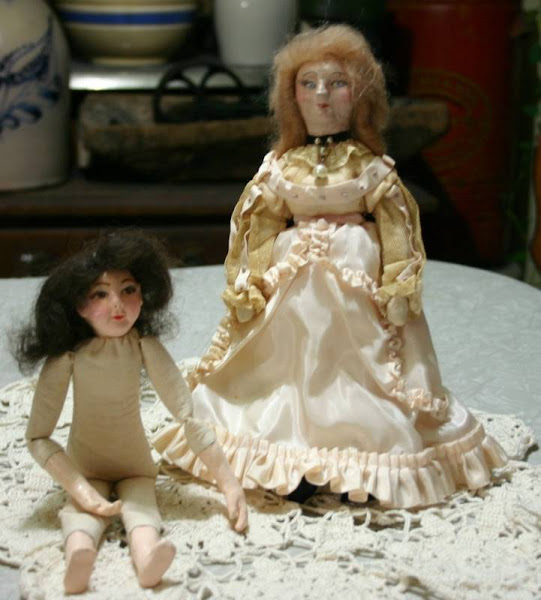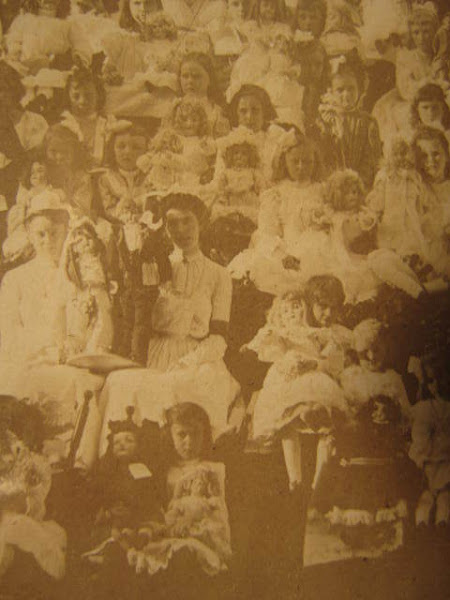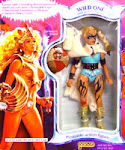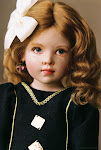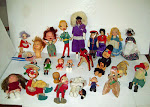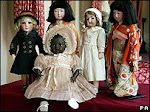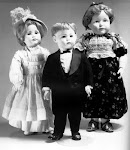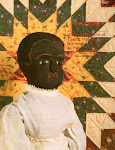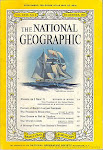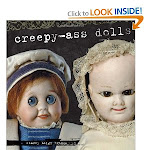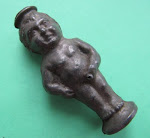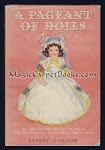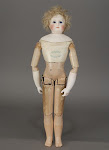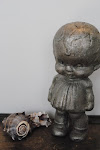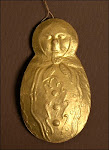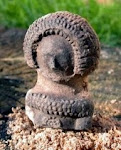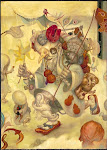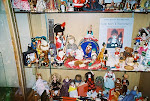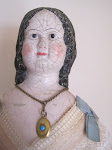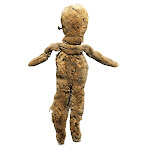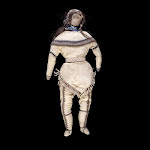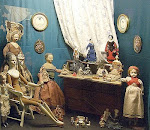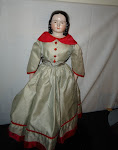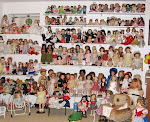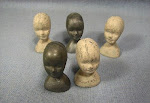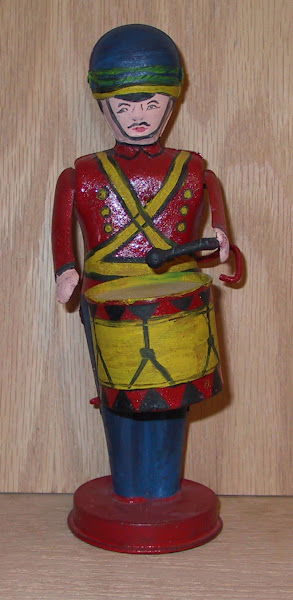Yes, that's right. She had her identity stolen by a female killer who used the elderly collector's cards to buy fairy tale costumes. Her victims were her friends, as well, and she dressed and posed them as Snow White and Red Riding Hood.
The dolls were posed on the elderly woman's furntiure. I saw several compo dolls, a china head, modern bisques, a few hard plastic. Of course, as is often the case, she was portrayed as eccentric, and a little silly. There were not that many dolls in the scene, but it was interesting. Castle is on ABC M nights. You might be able to catch the episode on ABC.org.
What ever happened to hobbies? Collecting used to be viewed as an art, or a talent, and collections impressed people. I've worked on badges for the Boy Scouts and Girl Scouts, and had lots of fun.
Go figure.
Tuesday, February 28, 2012
Monday, February 20, 2012
Draft of What I read for Midwest Modern Language Association 2011
A Literary Shelter for Misfit Dolls; Exploring Doll Play in Wilder, Dickens, Little Women, Burnette, and Eliot
Ellen M. Tsagaris, Ph.D.
When you loved the people of the world, you loved their dolls . . .
Anne Rice, Taltos.
Dolls have existed since the Stone Age and appear often in literature, but the literary signifcance of doll play has not been addressed. “Literary Dolls” are often bedraggled examples of their kind that would be at home on Rudolph’s Island of Misfit Toys. Yet, children love them because, like them, their dolls are imperfect. Laura’s doll in Little House in the Big Woods, a handkerchief wrapped corncob, is both an object of pity and a beloved toy. Dicken’s Jenny Wren repairs dolls to find the perfect form her own crippled body denies her. Beth’s dolls in Little Women, especially Joanna, are surrogate children and confidantes. Painfully shy, Beth can relate with her dolls as imaginary companions in ways she cannot interact with real children. Sarah Crewe’s proverty and privation as an orphan are shared by her doll Emily, her only companion when she loses her fortune and is reduced to being a servant at Miss Minchin’s Academy. Maggie’s doll in The Mill on the Floss is a “fetish” that takes all of the abuse the frustrated Maggie cannot heap on her oppressors, yet remains a faithufl confidante and compantion. If dolls are made in the images of their makers, they are also extension of their owners, and the image magic they recreate is often found in extensions of their owner’s lives, fears, and dreams.
Baudelaire: “A Philosphy of Toys”: Baudelqaire writes that “ the whole of life exists” in a “great toy shop” and it is “far more highly sparkling and polished than real life.” Those who love films like Mr. Magorian’s Wonder Emporium would probably agree with him. Dolls and toys represent life in miniature, brought to a scale and level that children can understand. A child’s life extends through the life of her toys, and her imagination animates them, as Andy’s does in the Toy Story Films. For a child, her dolls are her companions, portraits, actors in her plays, and scapegoats for her miseries.
Little Women, 1868, one year after my Great-Grandmother and Laura Ingalls Wilder were born: Nowhere does the doll represent an extension of her owner than in Alcott’s Little Women. Since the book was written, there have been hundreds of doll representations made of the characters, in paper and 3-D form, in all media. There are also many other works or art, both serious and kitschy, that immortalize them, as well as several films and TV series. Alcott herself was 13 when Charlotte Brontë died, and was aware of Jane Eyre. There, Brontë writes of the importance of dolls as companions to children, and the orphan Jane only has her doll to comfort her in the desolation of the Reed house.
The March girls do not have many toys, but they have their games, pastimes, and theatrical play. Beth is the only sister described as having dolls. Thirteen year-old Beth March is the shyest of the four March girls. She loves her pets, her six misfit dolls, and her music. Anne K. Phillips writes in “Toys, Games, and Play in Little Women” that given the family’s poor economic status, six dolls seem “ a surprisingly large number of toys” (407). Beth is a juvenile “Angel of the House,” and at thirteen, is her mother’s best companion. He helps with household chores, but is still very much a child who cares for her sisters bedraggled, broken, and cast out dolls. She often saves them from the trash or ragbag. The following description describes the relationship Beth has with her dolls:
Beth was too bashful to go to school . . . She was s housewifely little creature . . . not lonely nor idle, for her little world was peopled with imaginary friends . . .There were six dolls to be taken up and dressed every morning, for Beth was a child still, . . . not one whole or handsome one among them; all were outcasts till Beth took them in; for when her sisters outgrew their idols, they passed to her . . . Beth cherished them all the more tenderly for that very reason, and set up a hospital for infirm dolls. No pins were ever stuck into their cotton vitals; no harsh words or blows ere ever given them, no neglect ever saddened the heart to the most repulsive, but all were fed and clothed, nursed, and caressed, with the affection which never failed. One forlorn fragment of dollanity had belonged to Jo; and, having led a tempestuous life, was left a wreck in the ragbag, from which dreary poorhouse it was rescued by Beth, and taken to her refuge. (Alcott 35).
Alcott goes on to write that the poor doll has no top “to its heard” and “both arms and legs were gone, she hid these deficiencies by folding it in a blanket, and devoting her best bed to this chronic invalid. (35). Beth lavishes more love on this doll than on the others, and brings it “bits of bouquets,” reads to it, takes it for walks, “hidden under her coat,” and sings it lullabies, kissing “its dirty face, and whispering tenderly,” I hope you’ll have a good night, my poor dear” (35). Significantly, this doll is named Joanna. Later, when Beth is terminally ill, Jo will care for her as tenderly as Beth cared for the bedraggled Joanna. As Phillips observes, none of Beth’s play is “orchestrated by Marmee: Beth chooses this activity, and her dedication to the dolls is supported by her sisters” with Jo making sure there is a clear path, even in winter, so that Beth can take Joanna on her daily walks (408). Doll play suits the nurturing Beth, who is, ironically the most motherly of all the sisters, though she will never experience motherhood herself (408)
Indeed, there are many Victorian and Edwardian stories of dolls that have lead rough lives, only to be saved in some manner and given a new lease on life. Raggedy Ann manages to keep her smile “despite entanglement in laundry wringers, entrapment in drainpipes, and entombment in snow banks” (Eberle 180) . Rachel Field’s Hitty “survives many scrapes,” Miss Hickory of Miss Hickory loses her nut head but is reborn as part of a living tree, and Tottie of Godden’s A Dolls’ House is “proud to be made from the good wood of a strong tree” (180) ; her strong constitution helps her to give the other dolls, and herself, strength through some very difficult times in the doll house. There were many doll hospitals, and Jenny Wrens abounded all over the world. Antique dolls were sturdy, yet sometimes made of fragile materials, and even Burnett writes of having to replace a doll’s head. Parts were for sale everywhere, and the Alexander doll company got its start as a doll hospital. The New York Doll Hospital was famous for many years and was featured in at least two books and many articles, and even today, there is a “clinic” for American Girl dolls. Even the Cabbage Patch Kids got their start in a hospital setting, Babyland General Hospital, where the staff dressed as doctors and nurses. Well-loved dolls are often preferred by children [and collectors; there is a trend to collect played-with Barbie dolls, not MIB, see Lord]. My favorite dolls were the one’s completely worn out that “needed me,” and I frequently made and played with “crippled” dolls or paper dolls. My favorite part of Rudolph the Red Nosed Reindeer was The Island of Misfit Toys. I still like to save or salvage them, and many of my friends give me worn out specimens of “dollanity” that others might consign to the garbage can. I always save them. Even today, there is a brisk market for dolls that need TLC or doll parts on Etsy, eBay, and other auction sites.
Alcott herself tried at one point to support her family as a dolls dressmaker, reportedly chasing the neighbor’s chickens for feathers with which to decorate fancy doll hats (See review of McDonough’s The Life of Louisa May Alcott, 1).
If worn out dolls are preserved lovingly in Alcott’s books, they may also be sacrificed to ward off evil bogeymen of the nursery. In Little Men, in the chapter “Pranks and Plays,” Grover Smith, Jr. writes in his essay ”The Doll-Burners . . “ that Daisy and Demi, Rob, and Teddy, create a ritual to rid the “local bogy,” aka, “The Naughty Kitty-mouse” (Smith 28). The “nursery set” decides there must be a “sackerryfice” where “There must be a fire behind the big rock at two o’clock, and we must all bring the things we like best, and burn them!” (Alcott, LM, quoted in Smith 29). The last words, “burn them,” were said “with an awful emphasis on the last words” (29). One of the sacrificial victims must be a “venerable doll” named Annabella (29). After a fire is started on a flat stone, a dozen paper dolls, lead soldiers, etc., are all burned. Next comes a miniature village of wood. Finally, “comes the climax,” and Teddy “planted poor dear Annabella on the funeral pyre. Of course she did not like it, and expressed her anguish and resentment in a way that terrified her infant destroyer. Being covered with kid, she did not blaze, but did what was worse, she squirmed . . .The unexpected demonstration startled everyone and frightened Teddy half out of his little wits. He looked, then screamed, and fled toward the house roaring “mama,’ at the top of his voice” (29). Jo laughs as any adult might when she hears of the cremation and the reasons for it, but to children, the scene is truly horrifying. It is the stuff of horror movies like “Doll Graveyard” and has cultural roots in the Doll Temples of Japan where worn out dolls are cremated. So like us are dolls, that when they are destroyed this way, there is something horrific that stays with us, the same feeling one gets when a live person is burned in effigy. And, it is fitting at this point to keep in mind that among the first dolls were those that were buried or sacrificed with the dead to take the place of life people. Later, in Sons and Lovers, in Chapter 4 “The Young Life of Paul,” Smith writes that Lawrence also makes a sacrifice of Arabella, a doll which his sister is very fond of. Paul has broken the doll, and his way of atoning for his sin is to burn it. Perhaps the children are more cavalier with their toys because at this point in history, they have more than their mother and aunts would have had. Anne K. Phillips writes of the last part of Little Women, that “Later in the novel, Meg’s children Daisy and Demi are depicted as having more plentiful and more diverse kinds of toys” including a cooking stove and a group of wooden bears (408). As families became more prosperous in the 1870s, the toy market grew and grew, and there were more store-bought toys available. One sees the same effect in The Little House Books by Laura Ingalls Wilder. In the early books, Laura’s doll is a corncob, later replaced by a rag doll her mother makes, who is named Charlotte. Mary has a rag doll, and both girls make paper dolls. They use the ragbag to dress their dolls and make others out of twigs and dolls’ teacups out of acorn caps. Later, Nellie Olsen of a more prominent family has a china doll and an expensive wax doll, and Grace, Laura’s baby sister, has a china headed doll as well. And, Lawrence writes that Annie was disturbed by the destruction of the doll because her brother “seemed to hate the doll so intensely, because he had broken it (Lawrence 70-71, quoted in Smith 30). Smith calls the breaking of Arabella [note the similarity to Alcott’s Annabella; they would have been similar dolls] “a deliberate . . . assertion of bravado . . . [Paul’s] effeminate shame gives way to masculine pride. Dolls are also treated badly in Beatrix Potter’s “A Tale of Two Bad Mice” where Hunca Munca literally takes a doll house and its inhabitants by adverse possession until the dolls can be rescued and restored.
Jane Eyre:
Dolls play a role in the works of Charlotte Brontë, too, particularly Jane Eyre. Of her doll, the Orphan Jane says, “To this crib I always took my doll; human beings must love something, and, in the dearth of worthier objects of affection, I contrived to find a pleasure in loving and cherishing a faded graven image, shabby as a miniature scarecrow. It puzzles me now to remember with what absurd sincerity I doted on this little toy, half fancying it alive and capable of sensation. I could not sleep unless it was folded in my night-gown; and when it lay there safe and warm, I was comparatively happy, believing it to be happy likewise (Brontë______________).
Charlotte and her sisters and brother had many toys, especially given the time. One biographer tells us they had wax dolls with wardrobes and hats, painted wooden blocks and a lion, a toy barrel, a set of ninepins, a dolls cradle of wicker, dolls; tea sets, a toy iron, at least three sets of wooden soldiers, two sets of Turkish musicians and a set of Indians (Barker 150-151). They invented stories about their characters, particularly when they were tucked into bed at night and found solace in each other’s company, much as Jane did in her doll. From the soldiers, especially, came a troupe of The Young Men, and the children made up exciting and action filled plays about them. Later, they were to handcraft painstaking miniature books filled with the exploits of these characters based on toys. (Smith 31).
Shelter for Misfit Dolls: This is one of my favorite places on The Internet, though there has no new material since 2004. It is hosted by “The Little Dead Gyrl,” and has good information about outsider art dolls and primitive, homemade dolls. Artistry, not monetary value is stressed, creativity is celebrated. The doll now is showcased for the role the worn poppets of Brontë and Alcott exemplify, and a few are the fetish, punishment bearing toys, exemplified by Eliot.
The Shelter for Misfit Dolls illustrates by example several themes explored at hand. For one thing, it acknowledges that childhood is not all sweetness and light, and even as the Victorians would have us believe so, terrible things were happening to children in literature and in the real world. We need only to revisit the aforementioned Fairy Tales, Strupwelpeter, and Gorey’s cautionary tales like The Dwindling Party to know this is so. In fact, The Little Dead Gyrl features a series of vignettes that illustrate the tales and mishaps that befall luckless children by using small members of Mattel’s Barbie family, redressed to suit Gorey’s texts.
Furthermore, The Shelter is a place for artists to explore their own emotions and anxieties, and as the host writes in response to objections to her site: “We artists have found a constructive outlet for our anxieties, and we have become better people because of it. If you prefer to keep your denial and your neuroses and feel that everyone else should be denied their right to express their feelings, then by all means, stay off my website. “Love, Little Dead Gyrl
Moreover, the dolls featured are often grotesque, themes include “dolls and rot,” and adjectives that describe them include “grunge,” and “primitive.” Some are monster dolls or deformed dolls, like conjoined twin babies, and others sport taxidermy animal heads on conventional hard plastic and vinyl doll bodies. Others are vampires, witches, or Goth figures.
Some of the dolls are featured from the author’s collection, and a few are dolls by other artists that are collaborative efforts. The site truly exploits and explores the definition of what the dolls I, and her role in childhood. There is also a fondness for less-than-perfect dolls, homemade dolls, and worn, well-loved dolls. They seem to be preferred to valuable antiques and collectors’ items, and clearly, at The Shelter, condition is not everything. Some of the artist dolls are pricey, but there are “linkies” to “free doll stuff,” and a lot of sharing of links, patterns, and ideas for other craft sites. The Shelter seeks to encourage doll creativity in the spirit of Beth March, and Laura Ingalls’ corncob doll. There no “doll snobs” here and the status of these dolls is that they are not status items. “Shelter” and “misfit dolls” imply emotional attachments similar to what children have for their toys, and similar to what are explored in the Toy Story Films. The dolls, like their owners, need love, and indeed, represent their owners emotions, even if they are not life-like portraits.
The Little Dead Gyrl’s mission for The Shelter reads as follows:
Why Misfit Dolls??All ugly smelly chewed up dolls deserve a second chance at love. Many of them have a head start by already having become REAL (see The Velveteen Rabbit for definition of "real"). The official definition of a Misfit Doll is any doll which, due to any circumstances beyond its control (including but not limited to: bad luck, bad posture, bad parenting, chew marks, mysterious stains, homeliness, homelessness, musty odor, cloying saccharine sweetness, missing body parts, terminal illness, or lumpy stuffing) is UNLOVABLE by its owner. This site is a tribute to Weird Gyrl Artists who love to make weird creepy dolls! But this site is also a shelter for misfit dolls, so they will at least have an orphanage to live in while they are waiting for new parents.
“Just dolls to love” in Dolls, by Bettina Ehrlich, 1963: In this watercolor child’s picture book, made in miniature doll size, but five inches high, the author discusses dolls from around the world, old and new, from the perspective of a child. Each dolls is made of different materials, and at the end of the book, the child is asked which one she likes, and she answers, “Dolls, just dolls to love!”
Laura Ingalls Wilder:
The dolls featured in Wilder’s books are, for the most part, well-loved and homemade. Susan in LHBW is a corncob wrapped in a hankie. Laura, the younger sister, cannot have a doll more elaborate doll like Nettie, the cloth doll Mary owns, till she is older. Yet, Laura loves Susan and thinks enough of her to name her and clothe her. She has empathy for the simple doll, and the narrator expresses Laura’s sympathy by stating it is not Susan’s fault she is just a corncob; she still deserves to be loved. Here, the doll brings out nurturing qualities in children.
There are buckskin dolls mentioned in the LLHP books, and figurines, and dolls as Christmas ornaments as well. Dolls are often used as props in the television series of the 1970s as well, and there have been many dolls created in the image of the Ingalls family, and also in the images of the actors who played them on TV.
Their other toys are not elaborate, either. She and Mary must make doll cups out of acorns, and twig dolls and paper dolls out of bits and pieces. Their balloons are pigs bladders left over from butchering, and they play a lot of games and make snow candy or help with household chores as part of their games. Play is instructive for the Ingalls girls, literally playing house to learn skills befitting their later roles in life. They have few, if any store-bought toys. Laura is entranced with Charlotte, a doll her Mother creates from the ragbag, because she has eyes painted with homemade dye, and black hair, and real clothes. A special gift through Laura’s childhood is to have a new outfit made for her. Laura and Mary also play with paper dolls their mother cuts for them, and they create their own outfits.
Dolls mentioned in the later books are more prosperous, just as their owners are, so that Carrie and Grace have China or porcelain headed dolls, and the rich but spoiled Nellie Olsen has a wax doll that seems as if it were alive, and a porcelain doll. Unlike Laura and Mary, she has little regard for her toy, expensive as they are, and takes them for granted, even as she spitefully forbids Laura from touching her wax doll.
Realistic wax dolls and dolls of bisque and porcelain were at their height in the golden age of European doll making, especially in France and Germany. Wax dolls were being made in England by the firms of Pierotti, Montanari, Vargas, and Marsh that had each hair inserted into their heads with a hot needle. They had class eyes and realistic coloring. Bisque dolls had entire stores and trousseau devoted to them and innovations were made by firms like Huret and Rohmer, founded by women entrepreneurs, Jumeau, Bru, Gautier, and others. Dolls and their elaborate trousseau were popular charity items to be auctioned at Charity Fairs and Sanitary Fairs to benefit the Crimean and Civil Wars. Earlier, Florence Nightingale and Clara Barton played nurse to their dolls and pets as preparation for their future professions.
As with the March girls, the Ingalls girls could have bought tiny dolls and doll parts at general stores and through catalogs to enhance their dolls. They chose not to.
Dolls were their children and confidantes, but not their scapegoats. Unlike Maggie, and real children like Helen Keller who loved dolls, but who took out her frustrations on them and broke several as the rambunctious charge of Anne Sullivan. Keller writes in her autobiography that she first remembered sorrow and remorse after her breakthrough at the water pump when she remembered the doll she had broken. The doll was repaired; it may well be the doll she holds in the now famous, rediscovered photos of her and Sullivan.
Burnett: A Little Princess:
When told Sara is told she ought to play more with dolls, she replies, “You see, if I went out and bought a new doll every few days I should have more than I could be fond of. Dolls ought to be intimate friends. Emily is going to be my new intimate friend” (Burnett 7-8). When the sanctimonious and villainous headmistress Miss Minchin asks who Emily is, Sara solemnly says, “She is a doll I haven’t got yet. . .She is a doll papa is going to buy for me. . .. I have called her Emily. She is going to be my friend when papa is gone. I want her to talk to about him” (8). It is not, however, easy to find Emily, and there were a number of disappointments and visits to many celebrated toyshops, and there were at this time many, some dating to the 1700s. Of her search for Emily, Sara explained, “I want her to look as if she wasn’t a doll really. I want her to look as if she listens when I talk to her. The trouble with dolls, papa” . . . is that they never seem to hear” (9). In light of the Last Doll with her fantastic wardrobe, it is ironic that Sara is not looking for ostentation or cosmetic appearance in her search for Emily. She clearly wants a companion and confidante, not just a toy. Such an approach has been used as an advertising pitch to sell countless dolls for hundreds of years, along with an appeal to a love for realism, either in the children or the parents. At the time Burnett was writing, dolls were becoming more and more realistic, and were mechanical dolls that ate and drank including Bébé Teteur and Bébé Gourmand by Bru, the Edison talking doll by Thomas Edison with Jumeau heads, the mama doll invented by Maezel, the walking doll, Autoperipatetikos, and many more. Bisque heads now had real teeth, sleeping glass eyes, wigs of human hair, angora, or mohair, that could be combed and styled, jointed bodies that could be posed realistically, etc. Automatons that breathed, drew, danced, and sang were popular as well. And Sara looks at a fair variety of these, “they looked
At big ones and little ones—at dolls with black eyes and dolls with blue—at dolls with brown curls and dolls with golden braids, dolls dressed and dolls undressed,” and Sara even decided the doll if undressed could go to a dressmaker and have her things fitted, as Sara herself did, because “They will fit better if they are tried on” (9).
Finally, Emily is found. Burnett writes “as they were approaching a shop which was really not a very large one, Sara suddenly started and clutched her father’s arm. ‘Oh, Pap!’ she cried. “There is Emily!’” (9). Sara is flushed and “there was an expression in her green-gray eyes as if she had just recognized someone she was intimate with and fond of” (10). She is actually waiting of us!” she said :Let us go in to her.” Captain Crewe is startled a little and states he thinks they should be introduced. Sara replies they will introduce each other, but there is something uncanny in their meeting, “But I knew her the minute I saw her—so perhaps she knew me, too” [cf, Dollie Dearest, my Candy, and how collectors choose dolls].
Emily’s’ description is as follows: “Perhaps she had known her. She had certainly a very intelligent expression in her eyes when Sara took her in her arms. She was a large doll, but not too large to carry about easily; she had naturally curling golden-brown hair which hung like mantle about her ,and her eyes were a deep, clear, gray-blue, with soft, thick eyelashes which were real eyelashes and not mere painted lines” ( 10). Sara goes to a child’s dressmaker and Emily outfitted with wardrobe duplicate to hers, and says she wants Emily to look like a child with a good mother, but then says, “”I’m her mother, though I am going to make a companion of her” (10).
When Sara despairs after her father dies and she is reduced to being a servant in Miss Minchin’s cruel household, she stops believing in Emily; she knocks her off her chair and despair and rage crying, “You are nothing but a doll! Nothing but a doll-doll-doll! You care for nothing. You are stuffed with sawdust. You never had a heart. Nothing could ever make you feel. You are a doll!” (Burnett 124-125). Yet, the narrator tells us Emily looks at Sara with “glassy -eyed sympathy” (124).
Captain Crewe had made wonderful preparations for Sara’s birthday; [A]mong other things, a new doll had been ordered in Paris, and her wardrobe was to be , indeed, a marvel of splendid perfection. When she had replied to the letter asking if the doll would be an acceptable present, Sara had been very quaint. “I am getting very old, you see, I shall never live to have another doll given me. This will be my last doll. There is something solemn about it. If I could write poetry, I am sure a poem about ‘A Last Doll’ would be very nice. But I cannot write poetry. . . No one could take Emily’s place, but I should respect the last Doll very much; and I’m sure the school would love it. They all like dolls; though some of the big ones –the almost fifteen ones—pretend they are too grown up” (Burnett 62). The author would have known about dolls with extensive wardrobes; they were popular in her childhood, and are mentioned in other types of fiction. There were lawsuits and elaborate stores devoted to them and to their accessories. Burnett herself was a doll collector, and she often mentions dolls and toys in her books and has written about them.
Jenny Wren: Our Mutual Friend: Jenny is a an adult in a child’s body, and certainly both Madeleine and Claudia of Interview with the Vampire. She is a handicapped child who must repair and dress dolls for wealthier children to support herself and her alcoholic father, the perpetual child she calls Mr. Doll. She treats him like a doll, or naughty child, and he timidly submits to her domination; parental and child roles are clearly reversed: “How’s my Jenny” said the man , timidly; “How’s my Jenny Wren best of children, object dearest affections broken-hearted invalid?’ To which the person of the house, stretching out her arm in a n attitude of command, replied with irresponsive asperity: ‘Go along with you! Go along into your corner directly!’” (247). Her father-child then leaves to sit in the “chair of disgrace” (247), a sort of 19th century time-out. Jenny continues to scold him in what the narrator calls “this dire reversal of the places of parent and child, but is a pitiful expostulation to be let off from a scolding” (247). Jenny continues to scold with “I know your ticks and your manners . . . I know where you have been to! Oh, you disgraceful old chap!” (247). Doll making and dress making for Jenny is a chore, and she calls herself a “slave from morning till night” and angrily threatens to call the police and have her father “transported for life” (248).
It is soon clear Jenny is the responsible “parent, “ and she makes him count out wages, then, after threatening to give him the cats’ leavings, basically sends him to bed without his suffer (249).
At the end of the chapter, Dickens writes, “Poor dolls’ dressmaker! How often so dragged down by hand that should have raised her up. How often so misdirected when losing her way on the eternal road, and asking guidance! Poor, poor little dolls’ dressmaker!” (250).
a. [Write a novel from pov of Jenny W and a poem on Sarah’s The Last Doll].
(cf Claudia IWTHV); when she pays a visit with Riah, miss Abbey asks “Child or Woman? ‘Child in Years’ was the answer; ‘a woman in self-learner and trial.’ “(Dickens 454).
Dickens reproduces her calling card, which elevates Jenny in social status, reads “MISS JENNY WREN, DOLLS’ DRESSMAKER. Dolls attended at their own residences” (453). Jenny knows proper manners, and makes Riah stop the oral introductions while she gives her calling card to Miss Abbey.
Jenny takes pride in her work: “ . . . as they were going along, Jenny twisted her venerable friend aside to a brilliantly lighted toy shop window and said, ‘Now look a t ‘em. All my work!’ This referred to a dazzling semi-circle of dolls in all the colours of the rainbow, who were dressed for presentation at court, for going to balls, for going out driving, for going out to get married, for going to help other dolls to et married, for all the gay events of life (451). Jenny gets inspiration on the streets from great ladies she sees, and form other sources, and makes dolls in their images. Jenny is proud of the perfection of her dolls; unlike her own twisted form, their bodies are perfect and in proportion. In them, she reproduces the self she would like to have.
Jenny is introduced in the following way “The person of the house, dolls’ dressmaker and manufacturer of ornamental pin-cushions and pen-wipers, sat in her quaint low arm-chair, singing in the dark, until Lizzie came back. The person of the house had attained that dignity while yet of very tender years indeed, through being the only trustworthy person in the house” (Dickens 239). As Pym says, we all need something to love, a passion in our lives, but Jenny, like countless little girls who worked in the shops of Jumeau and others, made dolls they could not afford to have. The same is true today of young girls who work in doll factories making Barbies and other dolls they cannot have. Jenny has beautiful golden hair, and reminds the reader of Beth March, or Carol, of Kate Douglas Wiggins’ The Birds’ Christmas Carol.
Jenny’s real name is Fanny Cleaver, but she early on renames herself Jenny Wren (Dickens 239).
As she works, Jenny imagines the scents of flowers and listens for the songs of birds, for she cannot get out herself very often (244-45). She is wise beyond her years, and no doll is her companion; instead, the heroine Lizzie, comes to her with news of the outside world. (241). Yet, all the dolls are her messengers to the world she can’t inhabit, and a part of her goes on with them to new adventures. She scolds another character who wants to buy a doll from her admonishing, “you had better not . . . You are sure to break it. All you children do’ (244). Poor Eugene replies, “But that makes for good trade, you know, Miss Wren” (244). Jenny is a contrast; she is careful and aware of money, but her art seems to mean more to her than “good trade.”
Eliot: The Mill on the Floss: Jenny Wren’s dolls are symbolic if cultural trends; in fact, she is inspired to create them by watching the latest trends in societal and fashion trends in her Victorian world. Certainly, dolls “enculturate” children into social mores, and as Bado-Fralick and Norris point out in Toying with God: The World of Religious Games and Dolls, dolls also “enculturate children into a religions’ values (7 quoted in Norcia’s review in The Journal of Play 269). Maggie’s doll play in Mill explores further the thesis of Bado-Fralick and Norris, “whether dolls are empty vessels or objects freighted with meaning (Norcia 269). Maggie seems to offer the next question Norcia presents for the authors of Toying with God;” what happens when children go off script and subvert the play narratives that religious toys encourage?” My answer is we have Maggie and some of the children in Alcott, Godden, and the Toy Story Films who ritually abuse toys to take out their aggressions or to “sacrifice them.” We also have the Evil Doll Horror films, where abused dolls often come back to take revenge, e.g., Doll Graveyard or Dolls.
The attic is Maggie’s favorite “retreat,” and here she kept a Fetish which she punished for all her misfortunes. This was the trunk a large wooden doll, which stared with the roundest of eyes above the reddest of cheeks, but was now entirely defaced by a long career of vicarious suffering. Three nails driven into the head commemorated as many crises in Maggie’s nine years of earthly struggle’ the luxury of vengeance having been suggested to her by the picture of Jael destroying Sisera in the old bible. The last nail had been driven in with a fiercer stroke than usual, for the Fetish on that occasion had represented aunt Glegg.” But immediately afterward s Maggie had reflected that if she drove many nails in, she would not be so well able to fancy that the head was hurt when she knocked it against the wall, nor to comfort I, and make believe to poultice it when her fury was abated; for even aunt Glegg would be pitiable when she had been hurt very much, and thoroughly humiliated, so as to be her niece’s pardon. Since then she had driven no more nails in, but had soothed herself by alternately grinding and beating the wooden hear again the rough brick of the great chimneys . . . (Eliot 20).
The doll is a Queen Anne or Georgian, very rare today. Also, note again that Helen Keller and other children, including those in Alcott’s works and in Toy Story I, take out their frustrations on dolls. Children often bury dolls or use them as scapegoats, which is why they are important today in therapy for abused children.
Of fetishes, legendary doll historian and museum curator Max von Boehn writes, “Ancestor image, idol, fetish, talisman, amulet, depend in their general conception upon the idea that the presentation of a god or a demon or a man confers upon the person who makes the image and who calls by the name the thing represented the power to make use of its strength or to influence it. On these grounds the law Moses forbade, as idolatry, the making of images. . “Thus it is that the doll, both among ancient and among modern peoples, plays an important part in magical practice” (Von Boehn 56). He also defines the fetish in this way; “By the term fetish is understood a natural object or an object of art with which a cult is associated and to which its possessor ascribes supernatural powers . . . Any object can become a fetish, but generally human forms are preferred” (51).
Rice and Claudia: Anne Rice often uses dolls in her work, and they figure prominently in The Witching Hour, Lasher, and Taltos, as well as in Belinda, Interview with the Vampire, Merrick, and Queen of the Damned. She was, herself, a long time doll collector, and I am fortunate to own two of her former dolls and several of her books about dolls.
In both the novel and film of Interview, dolls are companions, portraits, and representations of corpses. In the film, the vampire child Claudia, who keeps growing intellectually but not physically, receives a doll every year for decades from Lestat, who just doesn’t get it; he has created for himself and Louis a perfect “doll” who is immortal, but who becomes a monster because of her frustration. The dolls covering her bed in the film become a grave or hiding place for the real “doll” she wants; the corpse of a real woman whose body and form she covets. Later, Claudia befriends Madeleine in Paris, a lonely doll maker who recreates dolls over and over in the image of the child she has lost. (Remember, Raggedy Ann was originally created in memory of a dead child, the artist’s daughter, Marcella). The two become close because they become each other’s living “dolls.” Madeleine can create an adult French Fashion doll of the type described earlier, which pleases Claudia, and Claudia can be Madeline’s living doll, a kind of consolation for her lost child. Claudia herself is a sort of tribute to the six year old little girl Rice lost to leukemia; she is the child who cannot die, but she and Madeleine are ultimately destroyed by the players of the Theatre de Vampires. A large Bru French doll is featured on the back cover of several edition of Interview. Last year, the doll was sold at auction for over $30,000.00.
In Taltos, Mr. Ash is a doll maker with a fantastic collection, and here Rice shows her knowledge as a collector by mentioning the fantastic makers Bru, Huret and Jumeau, and by showcasing their dolls. His mission is to create beautiful dolls in the style and quality of the antiques for little girls everywhere at affordable prices. And, as Rice notes, dolls represent the people who make them in a positive way, and she states that when you love the people of the world, you love their dolls.
Children like Sara Crewe and others, both real and fictional, often are attracted to dolls that remind them of home or some other comfort. Nona, the little Anglo-Indian girl sent to live with her English cousins in Miss Happiness and Miss Flower identifies with the ex-patriot Japanese dolls forced to live in a strange land without friends and family. She builds them a Japanese doll house, and in the process, makes friends who help her to recreate the beautiful miniature world the two Asian dolls must have missed. While the theme of Godden’s The Dolls’ House includes betrayal and even violent doll death by an interloper doll, it is clear that the Plantaganet family appreciates the care of the two little sister, Emily and Charlotte, [nee Bronte!] who rescue them, restore their house, and protect them from further damage and harm. The youngest sister identifies with the more damaged of the dolls, Mr. Plantaganet, who wears a bandage on his damaged china hand, and with Birdie, the fragile but loving celluloid mother doll who sacrifices herself to save her doll baby.
Edith the Lonely Doll, Corduroy the Bear, The Velvateen Rabbit, Miss Flora McFlimsey, Sethany Ann and Nicey Melinda, Pinnochio, The Nutcracerk Prince and many of their doll/toy counterparts can tell similar tales of having lived as children companions, confidantes, and even scapegoats. There are Victorian tales and poems written for children, and famous books like The Little Wooden Doll, Hitty: Her First Hundred Years, and The Memoirs of a London Doll that weave stories just like these, where dolls are mourned, loved, abused, restored, and loved by the children who own them. There are even poignant stories of dolls comforting children in slums, in concentration camps and prisons, in hospital wards, and other disconcerting places. The most poignant symbols left in the abandoned communities around Chernobyl are the dolls left behind, now forgotten lost prisoners, and the last artifacts of the children who loved them. Dolls are the other, but they are also extensions of humanity, miniature portraits of us who inhabit microcosms of our world, and inspire writers to recreate childhood their their doll characters as well as their human ones.
Ellen M. Tsagaris, Ph.D.
When you loved the people of the world, you loved their dolls . . .
Anne Rice, Taltos.
Dolls have existed since the Stone Age and appear often in literature, but the literary signifcance of doll play has not been addressed. “Literary Dolls” are often bedraggled examples of their kind that would be at home on Rudolph’s Island of Misfit Toys. Yet, children love them because, like them, their dolls are imperfect. Laura’s doll in Little House in the Big Woods, a handkerchief wrapped corncob, is both an object of pity and a beloved toy. Dicken’s Jenny Wren repairs dolls to find the perfect form her own crippled body denies her. Beth’s dolls in Little Women, especially Joanna, are surrogate children and confidantes. Painfully shy, Beth can relate with her dolls as imaginary companions in ways she cannot interact with real children. Sarah Crewe’s proverty and privation as an orphan are shared by her doll Emily, her only companion when she loses her fortune and is reduced to being a servant at Miss Minchin’s Academy. Maggie’s doll in The Mill on the Floss is a “fetish” that takes all of the abuse the frustrated Maggie cannot heap on her oppressors, yet remains a faithufl confidante and compantion. If dolls are made in the images of their makers, they are also extension of their owners, and the image magic they recreate is often found in extensions of their owner’s lives, fears, and dreams.
Baudelaire: “A Philosphy of Toys”: Baudelqaire writes that “ the whole of life exists” in a “great toy shop” and it is “far more highly sparkling and polished than real life.” Those who love films like Mr. Magorian’s Wonder Emporium would probably agree with him. Dolls and toys represent life in miniature, brought to a scale and level that children can understand. A child’s life extends through the life of her toys, and her imagination animates them, as Andy’s does in the Toy Story Films. For a child, her dolls are her companions, portraits, actors in her plays, and scapegoats for her miseries.
Little Women, 1868, one year after my Great-Grandmother and Laura Ingalls Wilder were born: Nowhere does the doll represent an extension of her owner than in Alcott’s Little Women. Since the book was written, there have been hundreds of doll representations made of the characters, in paper and 3-D form, in all media. There are also many other works or art, both serious and kitschy, that immortalize them, as well as several films and TV series. Alcott herself was 13 when Charlotte Brontë died, and was aware of Jane Eyre. There, Brontë writes of the importance of dolls as companions to children, and the orphan Jane only has her doll to comfort her in the desolation of the Reed house.
The March girls do not have many toys, but they have their games, pastimes, and theatrical play. Beth is the only sister described as having dolls. Thirteen year-old Beth March is the shyest of the four March girls. She loves her pets, her six misfit dolls, and her music. Anne K. Phillips writes in “Toys, Games, and Play in Little Women” that given the family’s poor economic status, six dolls seem “ a surprisingly large number of toys” (407). Beth is a juvenile “Angel of the House,” and at thirteen, is her mother’s best companion. He helps with household chores, but is still very much a child who cares for her sisters bedraggled, broken, and cast out dolls. She often saves them from the trash or ragbag. The following description describes the relationship Beth has with her dolls:
Beth was too bashful to go to school . . . She was s housewifely little creature . . . not lonely nor idle, for her little world was peopled with imaginary friends . . .There were six dolls to be taken up and dressed every morning, for Beth was a child still, . . . not one whole or handsome one among them; all were outcasts till Beth took them in; for when her sisters outgrew their idols, they passed to her . . . Beth cherished them all the more tenderly for that very reason, and set up a hospital for infirm dolls. No pins were ever stuck into their cotton vitals; no harsh words or blows ere ever given them, no neglect ever saddened the heart to the most repulsive, but all were fed and clothed, nursed, and caressed, with the affection which never failed. One forlorn fragment of dollanity had belonged to Jo; and, having led a tempestuous life, was left a wreck in the ragbag, from which dreary poorhouse it was rescued by Beth, and taken to her refuge. (Alcott 35).
Alcott goes on to write that the poor doll has no top “to its heard” and “both arms and legs were gone, she hid these deficiencies by folding it in a blanket, and devoting her best bed to this chronic invalid. (35). Beth lavishes more love on this doll than on the others, and brings it “bits of bouquets,” reads to it, takes it for walks, “hidden under her coat,” and sings it lullabies, kissing “its dirty face, and whispering tenderly,” I hope you’ll have a good night, my poor dear” (35). Significantly, this doll is named Joanna. Later, when Beth is terminally ill, Jo will care for her as tenderly as Beth cared for the bedraggled Joanna. As Phillips observes, none of Beth’s play is “orchestrated by Marmee: Beth chooses this activity, and her dedication to the dolls is supported by her sisters” with Jo making sure there is a clear path, even in winter, so that Beth can take Joanna on her daily walks (408). Doll play suits the nurturing Beth, who is, ironically the most motherly of all the sisters, though she will never experience motherhood herself (408)
Indeed, there are many Victorian and Edwardian stories of dolls that have lead rough lives, only to be saved in some manner and given a new lease on life. Raggedy Ann manages to keep her smile “despite entanglement in laundry wringers, entrapment in drainpipes, and entombment in snow banks” (Eberle 180) . Rachel Field’s Hitty “survives many scrapes,” Miss Hickory of Miss Hickory loses her nut head but is reborn as part of a living tree, and Tottie of Godden’s A Dolls’ House is “proud to be made from the good wood of a strong tree” (180) ; her strong constitution helps her to give the other dolls, and herself, strength through some very difficult times in the doll house. There were many doll hospitals, and Jenny Wrens abounded all over the world. Antique dolls were sturdy, yet sometimes made of fragile materials, and even Burnett writes of having to replace a doll’s head. Parts were for sale everywhere, and the Alexander doll company got its start as a doll hospital. The New York Doll Hospital was famous for many years and was featured in at least two books and many articles, and even today, there is a “clinic” for American Girl dolls. Even the Cabbage Patch Kids got their start in a hospital setting, Babyland General Hospital, where the staff dressed as doctors and nurses. Well-loved dolls are often preferred by children [and collectors; there is a trend to collect played-with Barbie dolls, not MIB, see Lord]. My favorite dolls were the one’s completely worn out that “needed me,” and I frequently made and played with “crippled” dolls or paper dolls. My favorite part of Rudolph the Red Nosed Reindeer was The Island of Misfit Toys. I still like to save or salvage them, and many of my friends give me worn out specimens of “dollanity” that others might consign to the garbage can. I always save them. Even today, there is a brisk market for dolls that need TLC or doll parts on Etsy, eBay, and other auction sites.
Alcott herself tried at one point to support her family as a dolls dressmaker, reportedly chasing the neighbor’s chickens for feathers with which to decorate fancy doll hats (See review of McDonough’s The Life of Louisa May Alcott, 1).
If worn out dolls are preserved lovingly in Alcott’s books, they may also be sacrificed to ward off evil bogeymen of the nursery. In Little Men, in the chapter “Pranks and Plays,” Grover Smith, Jr. writes in his essay ”The Doll-Burners . . “ that Daisy and Demi, Rob, and Teddy, create a ritual to rid the “local bogy,” aka, “The Naughty Kitty-mouse” (Smith 28). The “nursery set” decides there must be a “sackerryfice” where “There must be a fire behind the big rock at two o’clock, and we must all bring the things we like best, and burn them!” (Alcott, LM, quoted in Smith 29). The last words, “burn them,” were said “with an awful emphasis on the last words” (29). One of the sacrificial victims must be a “venerable doll” named Annabella (29). After a fire is started on a flat stone, a dozen paper dolls, lead soldiers, etc., are all burned. Next comes a miniature village of wood. Finally, “comes the climax,” and Teddy “planted poor dear Annabella on the funeral pyre. Of course she did not like it, and expressed her anguish and resentment in a way that terrified her infant destroyer. Being covered with kid, she did not blaze, but did what was worse, she squirmed . . .The unexpected demonstration startled everyone and frightened Teddy half out of his little wits. He looked, then screamed, and fled toward the house roaring “mama,’ at the top of his voice” (29). Jo laughs as any adult might when she hears of the cremation and the reasons for it, but to children, the scene is truly horrifying. It is the stuff of horror movies like “Doll Graveyard” and has cultural roots in the Doll Temples of Japan where worn out dolls are cremated. So like us are dolls, that when they are destroyed this way, there is something horrific that stays with us, the same feeling one gets when a live person is burned in effigy. And, it is fitting at this point to keep in mind that among the first dolls were those that were buried or sacrificed with the dead to take the place of life people. Later, in Sons and Lovers, in Chapter 4 “The Young Life of Paul,” Smith writes that Lawrence also makes a sacrifice of Arabella, a doll which his sister is very fond of. Paul has broken the doll, and his way of atoning for his sin is to burn it. Perhaps the children are more cavalier with their toys because at this point in history, they have more than their mother and aunts would have had. Anne K. Phillips writes of the last part of Little Women, that “Later in the novel, Meg’s children Daisy and Demi are depicted as having more plentiful and more diverse kinds of toys” including a cooking stove and a group of wooden bears (408). As families became more prosperous in the 1870s, the toy market grew and grew, and there were more store-bought toys available. One sees the same effect in The Little House Books by Laura Ingalls Wilder. In the early books, Laura’s doll is a corncob, later replaced by a rag doll her mother makes, who is named Charlotte. Mary has a rag doll, and both girls make paper dolls. They use the ragbag to dress their dolls and make others out of twigs and dolls’ teacups out of acorn caps. Later, Nellie Olsen of a more prominent family has a china doll and an expensive wax doll, and Grace, Laura’s baby sister, has a china headed doll as well. And, Lawrence writes that Annie was disturbed by the destruction of the doll because her brother “seemed to hate the doll so intensely, because he had broken it (Lawrence 70-71, quoted in Smith 30). Smith calls the breaking of Arabella [note the similarity to Alcott’s Annabella; they would have been similar dolls] “a deliberate . . . assertion of bravado . . . [Paul’s] effeminate shame gives way to masculine pride. Dolls are also treated badly in Beatrix Potter’s “A Tale of Two Bad Mice” where Hunca Munca literally takes a doll house and its inhabitants by adverse possession until the dolls can be rescued and restored.
Jane Eyre:
Dolls play a role in the works of Charlotte Brontë, too, particularly Jane Eyre. Of her doll, the Orphan Jane says, “To this crib I always took my doll; human beings must love something, and, in the dearth of worthier objects of affection, I contrived to find a pleasure in loving and cherishing a faded graven image, shabby as a miniature scarecrow. It puzzles me now to remember with what absurd sincerity I doted on this little toy, half fancying it alive and capable of sensation. I could not sleep unless it was folded in my night-gown; and when it lay there safe and warm, I was comparatively happy, believing it to be happy likewise (Brontë______________).
Charlotte and her sisters and brother had many toys, especially given the time. One biographer tells us they had wax dolls with wardrobes and hats, painted wooden blocks and a lion, a toy barrel, a set of ninepins, a dolls cradle of wicker, dolls; tea sets, a toy iron, at least three sets of wooden soldiers, two sets of Turkish musicians and a set of Indians (Barker 150-151). They invented stories about their characters, particularly when they were tucked into bed at night and found solace in each other’s company, much as Jane did in her doll. From the soldiers, especially, came a troupe of The Young Men, and the children made up exciting and action filled plays about them. Later, they were to handcraft painstaking miniature books filled with the exploits of these characters based on toys. (Smith 31).
Shelter for Misfit Dolls: This is one of my favorite places on The Internet, though there has no new material since 2004. It is hosted by “The Little Dead Gyrl,” and has good information about outsider art dolls and primitive, homemade dolls. Artistry, not monetary value is stressed, creativity is celebrated. The doll now is showcased for the role the worn poppets of Brontë and Alcott exemplify, and a few are the fetish, punishment bearing toys, exemplified by Eliot.
The Shelter for Misfit Dolls illustrates by example several themes explored at hand. For one thing, it acknowledges that childhood is not all sweetness and light, and even as the Victorians would have us believe so, terrible things were happening to children in literature and in the real world. We need only to revisit the aforementioned Fairy Tales, Strupwelpeter, and Gorey’s cautionary tales like The Dwindling Party to know this is so. In fact, The Little Dead Gyrl features a series of vignettes that illustrate the tales and mishaps that befall luckless children by using small members of Mattel’s Barbie family, redressed to suit Gorey’s texts.
Furthermore, The Shelter is a place for artists to explore their own emotions and anxieties, and as the host writes in response to objections to her site: “We artists have found a constructive outlet for our anxieties, and we have become better people because of it. If you prefer to keep your denial and your neuroses and feel that everyone else should be denied their right to express their feelings, then by all means, stay off my website. “Love, Little Dead Gyrl
Moreover, the dolls featured are often grotesque, themes include “dolls and rot,” and adjectives that describe them include “grunge,” and “primitive.” Some are monster dolls or deformed dolls, like conjoined twin babies, and others sport taxidermy animal heads on conventional hard plastic and vinyl doll bodies. Others are vampires, witches, or Goth figures.
Some of the dolls are featured from the author’s collection, and a few are dolls by other artists that are collaborative efforts. The site truly exploits and explores the definition of what the dolls I, and her role in childhood. There is also a fondness for less-than-perfect dolls, homemade dolls, and worn, well-loved dolls. They seem to be preferred to valuable antiques and collectors’ items, and clearly, at The Shelter, condition is not everything. Some of the artist dolls are pricey, but there are “linkies” to “free doll stuff,” and a lot of sharing of links, patterns, and ideas for other craft sites. The Shelter seeks to encourage doll creativity in the spirit of Beth March, and Laura Ingalls’ corncob doll. There no “doll snobs” here and the status of these dolls is that they are not status items. “Shelter” and “misfit dolls” imply emotional attachments similar to what children have for their toys, and similar to what are explored in the Toy Story Films. The dolls, like their owners, need love, and indeed, represent their owners emotions, even if they are not life-like portraits.
The Little Dead Gyrl’s mission for The Shelter reads as follows:
Why Misfit Dolls??All ugly smelly chewed up dolls deserve a second chance at love. Many of them have a head start by already having become REAL (see The Velveteen Rabbit for definition of "real"). The official definition of a Misfit Doll is any doll which, due to any circumstances beyond its control (including but not limited to: bad luck, bad posture, bad parenting, chew marks, mysterious stains, homeliness, homelessness, musty odor, cloying saccharine sweetness, missing body parts, terminal illness, or lumpy stuffing) is UNLOVABLE by its owner. This site is a tribute to Weird Gyrl Artists who love to make weird creepy dolls! But this site is also a shelter for misfit dolls, so they will at least have an orphanage to live in while they are waiting for new parents.
“Just dolls to love” in Dolls, by Bettina Ehrlich, 1963: In this watercolor child’s picture book, made in miniature doll size, but five inches high, the author discusses dolls from around the world, old and new, from the perspective of a child. Each dolls is made of different materials, and at the end of the book, the child is asked which one she likes, and she answers, “Dolls, just dolls to love!”
Laura Ingalls Wilder:
The dolls featured in Wilder’s books are, for the most part, well-loved and homemade. Susan in LHBW is a corncob wrapped in a hankie. Laura, the younger sister, cannot have a doll more elaborate doll like Nettie, the cloth doll Mary owns, till she is older. Yet, Laura loves Susan and thinks enough of her to name her and clothe her. She has empathy for the simple doll, and the narrator expresses Laura’s sympathy by stating it is not Susan’s fault she is just a corncob; she still deserves to be loved. Here, the doll brings out nurturing qualities in children.
There are buckskin dolls mentioned in the LLHP books, and figurines, and dolls as Christmas ornaments as well. Dolls are often used as props in the television series of the 1970s as well, and there have been many dolls created in the image of the Ingalls family, and also in the images of the actors who played them on TV.
Their other toys are not elaborate, either. She and Mary must make doll cups out of acorns, and twig dolls and paper dolls out of bits and pieces. Their balloons are pigs bladders left over from butchering, and they play a lot of games and make snow candy or help with household chores as part of their games. Play is instructive for the Ingalls girls, literally playing house to learn skills befitting their later roles in life. They have few, if any store-bought toys. Laura is entranced with Charlotte, a doll her Mother creates from the ragbag, because she has eyes painted with homemade dye, and black hair, and real clothes. A special gift through Laura’s childhood is to have a new outfit made for her. Laura and Mary also play with paper dolls their mother cuts for them, and they create their own outfits.
Dolls mentioned in the later books are more prosperous, just as their owners are, so that Carrie and Grace have China or porcelain headed dolls, and the rich but spoiled Nellie Olsen has a wax doll that seems as if it were alive, and a porcelain doll. Unlike Laura and Mary, she has little regard for her toy, expensive as they are, and takes them for granted, even as she spitefully forbids Laura from touching her wax doll.
Realistic wax dolls and dolls of bisque and porcelain were at their height in the golden age of European doll making, especially in France and Germany. Wax dolls were being made in England by the firms of Pierotti, Montanari, Vargas, and Marsh that had each hair inserted into their heads with a hot needle. They had class eyes and realistic coloring. Bisque dolls had entire stores and trousseau devoted to them and innovations were made by firms like Huret and Rohmer, founded by women entrepreneurs, Jumeau, Bru, Gautier, and others. Dolls and their elaborate trousseau were popular charity items to be auctioned at Charity Fairs and Sanitary Fairs to benefit the Crimean and Civil Wars. Earlier, Florence Nightingale and Clara Barton played nurse to their dolls and pets as preparation for their future professions.
As with the March girls, the Ingalls girls could have bought tiny dolls and doll parts at general stores and through catalogs to enhance their dolls. They chose not to.
Dolls were their children and confidantes, but not their scapegoats. Unlike Maggie, and real children like Helen Keller who loved dolls, but who took out her frustrations on them and broke several as the rambunctious charge of Anne Sullivan. Keller writes in her autobiography that she first remembered sorrow and remorse after her breakthrough at the water pump when she remembered the doll she had broken. The doll was repaired; it may well be the doll she holds in the now famous, rediscovered photos of her and Sullivan.
Burnett: A Little Princess:
When told Sara is told she ought to play more with dolls, she replies, “You see, if I went out and bought a new doll every few days I should have more than I could be fond of. Dolls ought to be intimate friends. Emily is going to be my new intimate friend” (Burnett 7-8). When the sanctimonious and villainous headmistress Miss Minchin asks who Emily is, Sara solemnly says, “She is a doll I haven’t got yet. . .She is a doll papa is going to buy for me. . .. I have called her Emily. She is going to be my friend when papa is gone. I want her to talk to about him” (8). It is not, however, easy to find Emily, and there were a number of disappointments and visits to many celebrated toyshops, and there were at this time many, some dating to the 1700s. Of her search for Emily, Sara explained, “I want her to look as if she wasn’t a doll really. I want her to look as if she listens when I talk to her. The trouble with dolls, papa” . . . is that they never seem to hear” (9). In light of the Last Doll with her fantastic wardrobe, it is ironic that Sara is not looking for ostentation or cosmetic appearance in her search for Emily. She clearly wants a companion and confidante, not just a toy. Such an approach has been used as an advertising pitch to sell countless dolls for hundreds of years, along with an appeal to a love for realism, either in the children or the parents. At the time Burnett was writing, dolls were becoming more and more realistic, and were mechanical dolls that ate and drank including Bébé Teteur and Bébé Gourmand by Bru, the Edison talking doll by Thomas Edison with Jumeau heads, the mama doll invented by Maezel, the walking doll, Autoperipatetikos, and many more. Bisque heads now had real teeth, sleeping glass eyes, wigs of human hair, angora, or mohair, that could be combed and styled, jointed bodies that could be posed realistically, etc. Automatons that breathed, drew, danced, and sang were popular as well. And Sara looks at a fair variety of these, “they looked
At big ones and little ones—at dolls with black eyes and dolls with blue—at dolls with brown curls and dolls with golden braids, dolls dressed and dolls undressed,” and Sara even decided the doll if undressed could go to a dressmaker and have her things fitted, as Sara herself did, because “They will fit better if they are tried on” (9).
Finally, Emily is found. Burnett writes “as they were approaching a shop which was really not a very large one, Sara suddenly started and clutched her father’s arm. ‘Oh, Pap!’ she cried. “There is Emily!’” (9). Sara is flushed and “there was an expression in her green-gray eyes as if she had just recognized someone she was intimate with and fond of” (10). She is actually waiting of us!” she said :Let us go in to her.” Captain Crewe is startled a little and states he thinks they should be introduced. Sara replies they will introduce each other, but there is something uncanny in their meeting, “But I knew her the minute I saw her—so perhaps she knew me, too” [cf, Dollie Dearest, my Candy, and how collectors choose dolls].
Emily’s’ description is as follows: “Perhaps she had known her. She had certainly a very intelligent expression in her eyes when Sara took her in her arms. She was a large doll, but not too large to carry about easily; she had naturally curling golden-brown hair which hung like mantle about her ,and her eyes were a deep, clear, gray-blue, with soft, thick eyelashes which were real eyelashes and not mere painted lines” ( 10). Sara goes to a child’s dressmaker and Emily outfitted with wardrobe duplicate to hers, and says she wants Emily to look like a child with a good mother, but then says, “”I’m her mother, though I am going to make a companion of her” (10).
When Sara despairs after her father dies and she is reduced to being a servant in Miss Minchin’s cruel household, she stops believing in Emily; she knocks her off her chair and despair and rage crying, “You are nothing but a doll! Nothing but a doll-doll-doll! You care for nothing. You are stuffed with sawdust. You never had a heart. Nothing could ever make you feel. You are a doll!” (Burnett 124-125). Yet, the narrator tells us Emily looks at Sara with “glassy -eyed sympathy” (124).
Captain Crewe had made wonderful preparations for Sara’s birthday; [A]mong other things, a new doll had been ordered in Paris, and her wardrobe was to be , indeed, a marvel of splendid perfection. When she had replied to the letter asking if the doll would be an acceptable present, Sara had been very quaint. “I am getting very old, you see, I shall never live to have another doll given me. This will be my last doll. There is something solemn about it. If I could write poetry, I am sure a poem about ‘A Last Doll’ would be very nice. But I cannot write poetry. . . No one could take Emily’s place, but I should respect the last Doll very much; and I’m sure the school would love it. They all like dolls; though some of the big ones –the almost fifteen ones—pretend they are too grown up” (Burnett 62). The author would have known about dolls with extensive wardrobes; they were popular in her childhood, and are mentioned in other types of fiction. There were lawsuits and elaborate stores devoted to them and to their accessories. Burnett herself was a doll collector, and she often mentions dolls and toys in her books and has written about them.
Jenny Wren: Our Mutual Friend: Jenny is a an adult in a child’s body, and certainly both Madeleine and Claudia of Interview with the Vampire. She is a handicapped child who must repair and dress dolls for wealthier children to support herself and her alcoholic father, the perpetual child she calls Mr. Doll. She treats him like a doll, or naughty child, and he timidly submits to her domination; parental and child roles are clearly reversed: “How’s my Jenny” said the man , timidly; “How’s my Jenny Wren best of children, object dearest affections broken-hearted invalid?’ To which the person of the house, stretching out her arm in a n attitude of command, replied with irresponsive asperity: ‘Go along with you! Go along into your corner directly!’” (247). Her father-child then leaves to sit in the “chair of disgrace” (247), a sort of 19th century time-out. Jenny continues to scold him in what the narrator calls “this dire reversal of the places of parent and child, but is a pitiful expostulation to be let off from a scolding” (247). Jenny continues to scold with “I know your ticks and your manners . . . I know where you have been to! Oh, you disgraceful old chap!” (247). Doll making and dress making for Jenny is a chore, and she calls herself a “slave from morning till night” and angrily threatens to call the police and have her father “transported for life” (248).
It is soon clear Jenny is the responsible “parent, “ and she makes him count out wages, then, after threatening to give him the cats’ leavings, basically sends him to bed without his suffer (249).
At the end of the chapter, Dickens writes, “Poor dolls’ dressmaker! How often so dragged down by hand that should have raised her up. How often so misdirected when losing her way on the eternal road, and asking guidance! Poor, poor little dolls’ dressmaker!” (250).
a. [Write a novel from pov of Jenny W and a poem on Sarah’s The Last Doll].
(cf Claudia IWTHV); when she pays a visit with Riah, miss Abbey asks “Child or Woman? ‘Child in Years’ was the answer; ‘a woman in self-learner and trial.’ “(Dickens 454).
Dickens reproduces her calling card, which elevates Jenny in social status, reads “MISS JENNY WREN, DOLLS’ DRESSMAKER. Dolls attended at their own residences” (453). Jenny knows proper manners, and makes Riah stop the oral introductions while she gives her calling card to Miss Abbey.
Jenny takes pride in her work: “ . . . as they were going along, Jenny twisted her venerable friend aside to a brilliantly lighted toy shop window and said, ‘Now look a t ‘em. All my work!’ This referred to a dazzling semi-circle of dolls in all the colours of the rainbow, who were dressed for presentation at court, for going to balls, for going out driving, for going out to get married, for going to help other dolls to et married, for all the gay events of life (451). Jenny gets inspiration on the streets from great ladies she sees, and form other sources, and makes dolls in their images. Jenny is proud of the perfection of her dolls; unlike her own twisted form, their bodies are perfect and in proportion. In them, she reproduces the self she would like to have.
Jenny is introduced in the following way “The person of the house, dolls’ dressmaker and manufacturer of ornamental pin-cushions and pen-wipers, sat in her quaint low arm-chair, singing in the dark, until Lizzie came back. The person of the house had attained that dignity while yet of very tender years indeed, through being the only trustworthy person in the house” (Dickens 239). As Pym says, we all need something to love, a passion in our lives, but Jenny, like countless little girls who worked in the shops of Jumeau and others, made dolls they could not afford to have. The same is true today of young girls who work in doll factories making Barbies and other dolls they cannot have. Jenny has beautiful golden hair, and reminds the reader of Beth March, or Carol, of Kate Douglas Wiggins’ The Birds’ Christmas Carol.
Jenny’s real name is Fanny Cleaver, but she early on renames herself Jenny Wren (Dickens 239).
As she works, Jenny imagines the scents of flowers and listens for the songs of birds, for she cannot get out herself very often (244-45). She is wise beyond her years, and no doll is her companion; instead, the heroine Lizzie, comes to her with news of the outside world. (241). Yet, all the dolls are her messengers to the world she can’t inhabit, and a part of her goes on with them to new adventures. She scolds another character who wants to buy a doll from her admonishing, “you had better not . . . You are sure to break it. All you children do’ (244). Poor Eugene replies, “But that makes for good trade, you know, Miss Wren” (244). Jenny is a contrast; she is careful and aware of money, but her art seems to mean more to her than “good trade.”
Eliot: The Mill on the Floss: Jenny Wren’s dolls are symbolic if cultural trends; in fact, she is inspired to create them by watching the latest trends in societal and fashion trends in her Victorian world. Certainly, dolls “enculturate” children into social mores, and as Bado-Fralick and Norris point out in Toying with God: The World of Religious Games and Dolls, dolls also “enculturate children into a religions’ values (7 quoted in Norcia’s review in The Journal of Play 269). Maggie’s doll play in Mill explores further the thesis of Bado-Fralick and Norris, “whether dolls are empty vessels or objects freighted with meaning (Norcia 269). Maggie seems to offer the next question Norcia presents for the authors of Toying with God;” what happens when children go off script and subvert the play narratives that religious toys encourage?” My answer is we have Maggie and some of the children in Alcott, Godden, and the Toy Story Films who ritually abuse toys to take out their aggressions or to “sacrifice them.” We also have the Evil Doll Horror films, where abused dolls often come back to take revenge, e.g., Doll Graveyard or Dolls.
The attic is Maggie’s favorite “retreat,” and here she kept a Fetish which she punished for all her misfortunes. This was the trunk a large wooden doll, which stared with the roundest of eyes above the reddest of cheeks, but was now entirely defaced by a long career of vicarious suffering. Three nails driven into the head commemorated as many crises in Maggie’s nine years of earthly struggle’ the luxury of vengeance having been suggested to her by the picture of Jael destroying Sisera in the old bible. The last nail had been driven in with a fiercer stroke than usual, for the Fetish on that occasion had represented aunt Glegg.” But immediately afterward s Maggie had reflected that if she drove many nails in, she would not be so well able to fancy that the head was hurt when she knocked it against the wall, nor to comfort I, and make believe to poultice it when her fury was abated; for even aunt Glegg would be pitiable when she had been hurt very much, and thoroughly humiliated, so as to be her niece’s pardon. Since then she had driven no more nails in, but had soothed herself by alternately grinding and beating the wooden hear again the rough brick of the great chimneys . . . (Eliot 20).
The doll is a Queen Anne or Georgian, very rare today. Also, note again that Helen Keller and other children, including those in Alcott’s works and in Toy Story I, take out their frustrations on dolls. Children often bury dolls or use them as scapegoats, which is why they are important today in therapy for abused children.
Of fetishes, legendary doll historian and museum curator Max von Boehn writes, “Ancestor image, idol, fetish, talisman, amulet, depend in their general conception upon the idea that the presentation of a god or a demon or a man confers upon the person who makes the image and who calls by the name the thing represented the power to make use of its strength or to influence it. On these grounds the law Moses forbade, as idolatry, the making of images. . “Thus it is that the doll, both among ancient and among modern peoples, plays an important part in magical practice” (Von Boehn 56). He also defines the fetish in this way; “By the term fetish is understood a natural object or an object of art with which a cult is associated and to which its possessor ascribes supernatural powers . . . Any object can become a fetish, but generally human forms are preferred” (51).
Rice and Claudia: Anne Rice often uses dolls in her work, and they figure prominently in The Witching Hour, Lasher, and Taltos, as well as in Belinda, Interview with the Vampire, Merrick, and Queen of the Damned. She was, herself, a long time doll collector, and I am fortunate to own two of her former dolls and several of her books about dolls.
In both the novel and film of Interview, dolls are companions, portraits, and representations of corpses. In the film, the vampire child Claudia, who keeps growing intellectually but not physically, receives a doll every year for decades from Lestat, who just doesn’t get it; he has created for himself and Louis a perfect “doll” who is immortal, but who becomes a monster because of her frustration. The dolls covering her bed in the film become a grave or hiding place for the real “doll” she wants; the corpse of a real woman whose body and form she covets. Later, Claudia befriends Madeleine in Paris, a lonely doll maker who recreates dolls over and over in the image of the child she has lost. (Remember, Raggedy Ann was originally created in memory of a dead child, the artist’s daughter, Marcella). The two become close because they become each other’s living “dolls.” Madeleine can create an adult French Fashion doll of the type described earlier, which pleases Claudia, and Claudia can be Madeline’s living doll, a kind of consolation for her lost child. Claudia herself is a sort of tribute to the six year old little girl Rice lost to leukemia; she is the child who cannot die, but she and Madeleine are ultimately destroyed by the players of the Theatre de Vampires. A large Bru French doll is featured on the back cover of several edition of Interview. Last year, the doll was sold at auction for over $30,000.00.
In Taltos, Mr. Ash is a doll maker with a fantastic collection, and here Rice shows her knowledge as a collector by mentioning the fantastic makers Bru, Huret and Jumeau, and by showcasing their dolls. His mission is to create beautiful dolls in the style and quality of the antiques for little girls everywhere at affordable prices. And, as Rice notes, dolls represent the people who make them in a positive way, and she states that when you love the people of the world, you love their dolls.
Children like Sara Crewe and others, both real and fictional, often are attracted to dolls that remind them of home or some other comfort. Nona, the little Anglo-Indian girl sent to live with her English cousins in Miss Happiness and Miss Flower identifies with the ex-patriot Japanese dolls forced to live in a strange land without friends and family. She builds them a Japanese doll house, and in the process, makes friends who help her to recreate the beautiful miniature world the two Asian dolls must have missed. While the theme of Godden’s The Dolls’ House includes betrayal and even violent doll death by an interloper doll, it is clear that the Plantaganet family appreciates the care of the two little sister, Emily and Charlotte, [nee Bronte!] who rescue them, restore their house, and protect them from further damage and harm. The youngest sister identifies with the more damaged of the dolls, Mr. Plantaganet, who wears a bandage on his damaged china hand, and with Birdie, the fragile but loving celluloid mother doll who sacrifices herself to save her doll baby.
Edith the Lonely Doll, Corduroy the Bear, The Velvateen Rabbit, Miss Flora McFlimsey, Sethany Ann and Nicey Melinda, Pinnochio, The Nutcracerk Prince and many of their doll/toy counterparts can tell similar tales of having lived as children companions, confidantes, and even scapegoats. There are Victorian tales and poems written for children, and famous books like The Little Wooden Doll, Hitty: Her First Hundred Years, and The Memoirs of a London Doll that weave stories just like these, where dolls are mourned, loved, abused, restored, and loved by the children who own them. There are even poignant stories of dolls comforting children in slums, in concentration camps and prisons, in hospital wards, and other disconcerting places. The most poignant symbols left in the abandoned communities around Chernobyl are the dolls left behind, now forgotten lost prisoners, and the last artifacts of the children who loved them. Dolls are the other, but they are also extensions of humanity, miniature portraits of us who inhabit microcosms of our world, and inspire writers to recreate childhood their their doll characters as well as their human ones.
For Violet Page
Happy Birthday to my dear friend Violet, who would have been 106 today. Her full name was Violet Ellen Eckstrom Page. She made dolls in Cenral Illinois for over 50 I met her when I was 14, and she 69. I was her good friend till I was 41 and she passed away. She made porcelain dolls, cloth dolls, all kinds. She loved to collect, and sold at shows. My best antique dolls came from her, and she taught me me to make, assemble, and repair dolls. I will always love her. My mother is now with her, and I will never forget her. Great doll makers should be remembered, and this is my tribute to my dear friend.
Dolls In Horror Movies; MMLA 2011/Creepy Dolls Indeed!
Ellen Tsagaris, Ph.D.
May 28, 2011
“Antique Haunted Doll. Health, Wealth and Good Fortune.” http://cgi.ebay.com/ws/eBayISAPI.dll?ViewItem&item=220824235795&assPageName=AD …
Creepy doll blog for conclusion:
“They Want to Play with You;” Cinematic Demonic Dolls and Demonic Child’s Play in Stuart Gordon’s Dolls; Interview with the Vampire, Toy Story III, The Bad Seed, The Chucky Films, Dead Silence, Koontzs’ Intensity, and The Tommy Knockers.
Play often rewards us with a thrill or a sense of wonder. But, just over the edge of play, uncanny objects like dolls, automata, robots, and realistic animations may become monstrous rather than marvelous. . . . Play is surely difficult to define, but demarcating its porous boundary—where what one moment creates joy can in the next, cause dread—is a useful step toward describing this shifting phenomenon.
Scott G. Eberle, “Exploring the Uncanny
Valley to Find the Edge of Play”
If there Is a dead body in the room—
Cover it,
That it does not become the gruesome
Doll of the (childish) house
That he does not play with it
Erecting it,
Against . . .
Rainier Maria Rilke, The Duino Elegies
Dolls are “The Other.” They can appear alive, yet are peculiarly “dead.” They can be a child’s confidante, or a portrait of depravity and cruel weapon as are voodoo dolls and certain talismans. Freud’s essay “The Uncanny” and Rilke’s essay “The Dolls” foreshadow how dolls are appropriated in horror films to become weapons of terror or animated small corpses, intent on evil acts. Children can also be monsters; depraved creatures that, along with their demonic toys, are the antithesis of idealized childhood innocence. In fact, books like the recent Creepy – Ass Dolls and websites like The Haunted Doll Museum , Headless Historical Dolls, and The Shelter for Misfit Dolls exploit the darker side of dolls and child’s play to the delight of thousands of fans. There is even a haunted dolls category on eBay, where the dolls sold have a “haunted history.” One recent offering says that the doll, a bisque doll made in the late seventies or early eighties, “promotes a long healthy life for her owner as well as bestows great amounts of money to her owner and their family” (Antique Haunted Doll 1). For example, her owner might find money on the ground. The description on eBay goes on to say that there is a short chant or mediation to get the doll to work. (Ibid). Dolls in horror literature of all media do want to play with you, but not in the safe, innocent, or productive sense we usually associate with doll play. Horror dolls don’t encourage nurture; they encourage self-defense. This paper will explore how little girls and their most traditional of toys, dolls, are appropriated in the horror films named above to create a particularly grim and terrifying experience for film audiences.
Intro: Dolls were not meant to be toys for children, initially, but were ritual objects, tomb figures, representations of deities [The Goddess figures or Venuses of Willendorf], ancestor images, fetishes, Santos, objects d’art and utilitarian objects. Both Carl Fox [The Doll] and Max von Boehn [Dolls] explore the darker ancestry of what has now become a children’s toy and popular collectible. In some ways, doll horror films hearken back to the time when dolls were more than trivialities and ephemeral childhood entertainments to explore their darker side, and the uncanny effect these miniature human portraits have on us in a cinematic context.[The cult classic Trilogy of Terror exploits the darker side of fetishes and ritual figures when one comes to life and wreaks mad-cap havoc on Karen Black].
So sacred were dolls or figurines to Stone Age people, that they lacked facial features, for it was taboo to look on the face of the deity or God [similar to current religions, both Islam and Amish, that do not portray human faces on dolls, statues, or paintings, or photographs; it is an ancient prohibition against graven images]. Doll “murders, burials, and executions” are an integral part of play; witness Frances Glessner Lee’s miniature doll murder scenes in The Nutshell Series of Unexplained Death and the Lincoln boys’ doll Jack, which was repeatedly court martialed and executed. Dolls are often given to abused children not only to comfort them, but to encourage them to discuss their own physical and mental abuse. Funerary dolls were common in the ancient world, and dolls are cremated in temples in modern Japan.
Both Louisa May Alcott and D.H. Lawrence write of dolls being burned on sacrificial, childish altars, (Alcott, Little Men, 29; Lawrence, Sons and Lovers, 70-71). Maggie Tulliver abuses her dolls as a “Fetish” in The Mill on the Floss” when she is upset and frustrated (Eliot, Mill, 20). One of the props in a recent production of Jane Eyre (2011) is a burned doll. The doll is a good replica of the so called Milliner’s Models of the 1830s, made in Germany with elaborate molded hairdos of papier mache with papier mache limbs and kid bodies.
Today, we have circled back to the idea of dolls as fetishes of sorts; we have only to review the numerous publications devoted to dolls, especially Barbie and ball-jointed Asian dolls. There are national and local doll clubs all over the world, and the rise in creation of artist or collectors dolls as burgeoned since the 1980s. Dolls are often status symbols, and I have seen young women carrying Blythe dolls, with their enlarged heads and oversized mechanical eyes, and Japanese ball-jointed dolls with their interchangeable wigs and heads, down the street. American Girls fill the same need for young girls, and it is not unusual to see the well-dressed pre-teen taking her American Girl with her to shops and restaurants, especially the American Girl Place shops created just for them. As Eberle writes, “Monstrosity and oddity gave way to a fascination with the cute” (189). “Eva-Maria Simms has written of dolls that “[s]he profoundly attracts the child’s desire, evokes passionate love and hate, and fulfills needs that are difficult to articulate in any other way than through play” (Simms 664).
Children not only enjoy burying and abusing their toys, as exemplified by the examples above and by the Toy Story Films, they often abuse them as sheer acts of aggression. Not all children who abuse toys are frustrated and upset themselves. Also, :”grossology ” or racy children’s rhymes and cruel jokes are a fascinating part of childhood. As the Baby says in Rugrats when asked why babies are so fascinated with “poop,” “Where do we start!” Noted author Brian Sutton-Smith discusses in” Play Theory, A Personal Journey and New Thoughts,” how he collected 155 kids’ jokes from local school which he and his staff dubbed “ Cruel Jokes, Bloody Marys, Hate Jokes, Ivy League Jokes, Sadist Jokes, Gruesomes, Grimmsels, Sick Jokes, Meanie Jokes, and the Comedy of Horrors” (Sutton-Smith 92). Sutton-Smith then created the following subcategories Murder, Cannibalism, Corpses, Beasts, Excrement, and Indifference to the Young.
Why do children love such “malodorous” and antisocial jokes and play? Sutton-Smith notes that many experts call this “intentionally contrary type of play” ” flexible, divergent thinking, . . anarchism . . . desire, interdeterminism, psychic masochism, dark play, inversion . . subversion, mockery, willfulness, illicit play, cruel play, masks, festival hazing, disorderly exaggerative, irrational powers, grievance syndromes and grotesque realism “ ( 93). He notes that of the 155 jokes he collected and studied, nearly all illustrated “disrespect of conventional behavior or conventional thought or good manners” (96). Sutton-Smith observes that the children he studied in 1959 and 1981, the jokes constituted “rebellious expression”, and imply that “play allows children to overcome the stuffy and bossy adult world they encounter”(96). Horror movies featuring demonic toys and dolls allow filmmakers, and their audiences, to do the same. They, too, are a reaction against the “stuffy norms” of society, and maybe film making. They incorporate the doll’s early history shrouded in magic and ritual, if not outright witchcraft, and use the doll and her history to rebel against traditional notions of play and entertainment. As with many horror films, the demonic doll films show some form of “good” triumphing over evil.
As Stephen King writes in his essay, “Now you take Bambi . . .” [I]t’s been
suggested again and again that such entertainment offers us a catharsis – a chance to enter
for a little while a scary and yet controllable world, where we can express our fears,
aggressions, and possibly even hostilities. Surely no one would suggest that children do
not have their fears and hostilities to face and overcome; those dark feelings are the basis
of many of the fairy tales children love best.”
Stuart Gordon’s Dolls- Defining the Uncanny - Still, good triumphs over evil through some very uncanny effects. Cute dolls who come to life as murderous demons are the uncanniest evil effect of all, perhaps because dolls are images of ourselves.
But, why are among all toys are dolls constantly used as the evil elements in horror film and literature; why are they the most uncanny? Since Freud, and even earlier, writers have explored the thesis that dolls are uncanny through a definition of their own creation. Freud writes in his famous essay, “The Uncanny,” that “the word is not always used in a clearly definable sense, so that it tends to coincide with what excites fear in general; yet we may expect that a special core of feeling is present which justifies the use of a special conceptual term (1). Freud discuss the work of Jentsch, and states that the latter “quite rightly lays stress on the obstacle presented by the fact that people ‘vary so greatly in their sensitivity to this quality of feeling” (1). [The study Eberle writes about concerning the two different baby dolls bears out Freud’s comment; some found the dolls charming and wholesome, others found them nauseating and creepy, too real, odd, and unsettling. (Eberle 185-187.]
Scott G. Eberle calls the word “uncanny” itself “peculiar” in this article “Exploring the Uncanny Valley to find the Edge of Play” (168). He describes an uncanny feeling as one that “lies just astride the boundary of play. This disquieting, unnerving, spooky and somewhat sickly sensation contrasts with the pleasure and ease we feel at play” (168). Though, I might add, it does thrill us in a cathartic sort of way. “Uncanny” is also discussed in connection with the German, unheimlich, from the root, heimlich, or homely, to the negative, unhomely or unheimlich, as adjective, das Unheimlich, “the unhomely”(168). Eberle argues that uncanny, when on par with “the beautiful” or “the sublime” “describes an odd sense that arises from an encounter with an object that looks real enough to be real, or that moves realistically enough to seem real,” but is not (168).
Eberle refers to clockwork figures and various automata, [which include Japanese Karakuri], and mechanical toys, made by the famous firms Lambert, Jaquet-Droz, Vichy, and others. These early doll/robots could draw, breathe, sing, imitate human sound and movement, transcribe poems, dance, etc. They were popular in the 18th and early 19th centuries, too, Eberle is correct that popular gothic tales of the time contributed to the eerie impressions created by automatons;”[s]tories of the day were filled with ghosts, the revivified dead, vampires, mysterious doubles, and evil automata” (168). He further notes that difficult times [Wars, the French and American Revolutions, European political upheavals and other reigns of terror inspire such gothic horror tales and reflect the times. As the Marquis de Sade himself said in defense of his gruesome works of psychosexual terror, “You accuse me of writing horrors;” but I can’t begin to compete with the real horror that is going on all around us.” In the 20th and 21st centuries, we have tales of wax museum figures coming to life in films and in anthologies like Alfred Hitchcock Presents. Eberle talks of Jentsch’s writings about the uncanny, and notes that the French craftsmen were making these figures 100 years before him, but in reality, automata date to ancient and medieval times as well. Collections of automata still exist, and their progeny are the Disney animatronics, which inspired and are nodded to in The Stepford Wives. Indeed, the first time I saw the Lincoln animatronic in Disneyland’s “Great Moments with Mr. Lincoln,” I was sure it was an actor playing the president, and I was very disconcerted to be told it was an elaborate robot, or if you will, mechanical doll.
Freud, a collector of ancient figurines, dolls, and small art objects himself, was prompted to write “The Uncanny” by tales written by E.T.A. Hoffman, creator of “The Nutcracker.” Hoffman write also “Die Automata,” and the story which inspired Freud, “Olympia,” an Orpheus and Eurydice tale where a man falls in love with an automaton that seems so real that he mistakes her for being alive, when she is not. The problem with such super-realistic figures and dolls is that they are “too much” like a human being, “yet not enough” like them. For one thing, while these objects can move and even sound like human beings, their creators have not perfected the art of human facial expression; their faces hardly ever change, and if they do, as in the case of some of the dolls, the expressions are disconcerting and not believable. Also, the eyes seem to stay fixed; witness the effect, though comic, of the marionettes in the film Team America or the Don Quixote puppet in the PBS commercial to cuts his strings, or the statue Chac Mol in the Carlos Fuentes story of the same name who comes to life and takes over his owner’s existence.
Mashihiro Mori, a Japanese robot expert coined the phrase “the uncanny valley” in 1970 (Eberle 175). He wanted to describe the “relationship of familiarity and similarity in human likenesses and the positive or negative feelings that they engendered” (175). Automatons are lifelike machines, but they are flawed, and they “jar our beliefs about how living things should look and move” (175), and indeed, this is the feeling engendered by the animatronic Stepford Wives, Dollie Dearest, and other such creatures. It is the reason my two dogs ran from Julie, the Living Doll, an animatronic doll that responded to questions, light, and dark, and to Baby Secret, a late 60s talking doll that moved its lips.
Ranier Marie Rilke had very specific opinions about dolls. Rilke was horrifically thrilled by dolls, in part because his mother made him sleep in a room inhabited by the large, 19th century glass-eyed bisque dolls that looked like real children. At night, he could make out their outlines in the shadows, and he writes many years later that they terrified him because they seemed so alive, yet were not. In fact, Rilke wrote in his essay “Dolls” that Dolls “appeared in dreams and were tied up in the disasters of feverish nights. They did not make any effort of their own; they were lying at the edge of childhood sleep, maybe filled with rudimentary thoughts of falling off , and they let themselves be dreamed. Just as they were accustomed to be lived tirelessly through someone else’s power during the day” (Rilke quoted in Simms 663).
So thrilled was Rilke by doll horror that he even wrote a story about a corpse/doll called “Frau Blaha’s maid” where a baby’s body is hidden in a trunk as a “big doll” that is taken out and set up than a puppet theater (Simms 665). Rice plays on the confusion between doll and corpse in her screenplay for Interview with the Vampire where Claudia hides the nude corpse of a woman, one of her victims, in bed amid all the other dolls she has collected over the sixty five+ years of her childhood existence. Rilke has written hat dolls are “superficially painted drowned corpse[s] lifted and carried by the flood of our tenderness” (quoted in Simms 670).
The director of Dolls, Stuart Gordon, understands that dolls can be both innocent and eerie. Anne Rice has written that “when you loved the people of the world, you loved their dolls. . .” and Japanese and other cultures believe that human images, including dolls, include the souls of those who made them and owned them. It is one small step from these beliefs for Gordon to imagine that nasty, dysfunctional adults could be turned into magic mechanical dolls that could do the bidding of their maker.
Eva Maria-Simms argues that up to the time she was writing in 1996, the doll “”although featuring prominently in many female children’s lives, has found little attention from the academic community” (Simms 663). The same, she writes in “Uncanny Dolls: Images of Death in Rilke and Freud” is true of psychoanalysis (663). Yet, she notes that dolls have prompted more investigation by these disciplines because they, “like other toys, allow the child to project unconscious processes and facilitate the resolution of conflicts which the child is unable to articulate” (Erik Erickson, Childhood and Society, quoted in Simms 663). Certainly the aggressive, often murderous dolls portrayed the films here discussed represent and showcase the aggressive behavior their childhood companions sometimes want to express. Judy in Dolls, for example, imagines her lost teddy bear coming back as a Grizzly that hunts to destroy and devour her callous parents. Chucky, at some level in the first Child’s Play, is the very bad little foster child taking out his frustration on the foster parents and the system that took away his home. While Dollie Dearest seems to control and possess her little girl owner, she is also the child’s companion in a new, strange, and lonely environment. Many of her actions could easily reflect her owner’s displeasure at being transplanted so far from friends and home. Simms writes that the doll is the child’s “primary entry into the world of the imagination” because “the doll, among all the toys, comes closest to imitating the child’s own body: and thus “lends itself to an imaginative representation of the human world” (672). With dolls, Simms goes on to argue, a child can play at any adult rule or in any adult situation, house, school, grocery store, restaurant (672), even jail, prison, and execution. Rilke also rights that “[we] found our orientation through the doll” (Rilke Quoted in Simms 672).
Summary:
There are many kinds of responses to various artifacts, according to Alfred Gell, “terror, desire, awe, fascination, etc”( Gell p. 6 quoted in Wiseman 5).
Dolls [Dir. Stuart Gordon]: As one review writes, “”At once whimsical and creepy, the film creates in the viewer a sense of child-like wonder and makes one feel as though they’re seeing the bizarre events of the film through the eyes of 9-year old star Carrie Lorraine”(doll 4baby 1). In fact, Judy and Ralph, the child-like adult she befriends, escape the fate of the other selfish, mean adults because they are innocent, and the “little people” as Judy calls the dolls, are their to punish inherent evil by teaching it a lesson, not inherent good. The dolls, themselves once selfish, cruel adults, remain toys to atone for their past sins, and Gabriel and Hilary, the doll makers, preside over their toy army, ready to teach a lesson to all unwitting travelers who land at their door.
Plot: Six people are caught in a storm in the English country side. The setting is very Gothic. Judy is a little girl traveling with her selfish detached dad and a nasty, controlling, narcissistic step-mother. They are joined in a gothic, spooky, quintessential “haunted house” by Ralph, a kind businessman who ahs picked up two teen aged girls hitchhiking; the girls are very punk.
The spooky mansion is owned by Gabriel and Hilary Hartwicke charming, elderly toy makers who have a fantastic collection of dolls, puppets, and toys.
The nasty, selfish guests are attacked one by one by the dolls. The dolls themselves are “cursed, immoral people that have been killed and imprisoned in toys to pay for their crimes by the owners of the house,” powerful witches. (http://en.widipeida.org/wiki/Dolls_(1987-film), p.1. The dolls punish Judy’s parents for not loving her and being bad parents. The dad is turned into the doll he destroyed after it attacked him. The punks are punished for trying to steal antique dolls, one is beaten, and another is killed by a toy soldier firing squad [best scene in the film!].
Ultimately, Ralph and Judy are spared because they are “pure of heart” (Ibid). Ralph and Judy are allowed to leave together, to find Judy’s mother. They are bid fond farewell by the toy makers, who invite them back because they know they “show respect to the childhood world and its mysteries” (Ibid 2).
The symbolism of this film is not lost on those paying attention. Judy has a doll named Punch as her companion, and her parents have a sort of Punch And Judy marriage full of insults. Her father is later turned into the Punch doll, and he and his wife Rosemary are more Commedia dell Arte characters than real people. Also interesting is the fact that the dolls are custom-made Italian puppets, a la the CDA tradition, and also real collectors and antique dolls.
At least one reviewer thinks the film has been successful with a select body of evil doll movie fans because “dolls are f ****** creepy” (The Girl Who Loves Horror Movies 3). One interesting effect is that doll mayhem is often signaled by a music box which begins playing by itself. When it is playing, a tiny doll ballerina dances. This is truly an example of a childhood icon entering Eberle’s uncanny valley. Many little girls , including this one, remember being enchanted by the tiny dancer that twirled inside their music/jewel boxes. Here, something innocent signals the beginning of something sinister. The dolls that attack, specially made Italian puppets, have tiny vampire teeth. They are uncanny not just because they are animated dolls, but they are used to foreshadow what will happen to the “bad” houseguests; they, too, were once selfish, mean adult humans, now doing penance in doll form.
Something else that adds to the film’s verisimilitude, even if we don’t want to believe it, are the real doll props. There are antique dolls, porcelain dolls, bisque dolls, vinyl dolls from the sixties and seventies, stuffed toys, and other collectors items scattered in every corner of the set. The doll that Hilary pushes in the antique baby buggy is an 1820s-30s wax doll, from England. These dolls, as they age, often crack and become “crazed,” lending them a somewhat creepy expression. It is the perfect part for the ghostly baby buggy scene, where Hilary, in the middle of the night, pushes the pram up and down singing “Rock- a-bye Baby,” and once again, an innocent lullaby turns to something sinister.
My favorite scene has to be the Toy Soldier firing squad, whereby one of the punk girls gets what’s’ coming to her, and then is turned into a doll herself. So, the plot is not so much horror movie as fairy tale, and Ralph and Judy are like Hansel and Gretl in the wilderness, abandoned by everyone to find their own way. Ralph tells Judy that when he was young he believed his toys came alive when he wasn’t looking, and the doll Punch, later reminds him of this when he implies that Ralph knows the truth about the dolls. Ralph is spared because, as Gabriel encourages him, he wakes up his inner child, and his terrified belief in the dolls pleases them. They know he and Judy understand them, and take them seriously, and as Judy says early on when asked if she is afraid of the dark, “No, afraid of what’s in the dark.”
http://en.widipeida. Org/wiki/Stuart_Gordon
Esplatter; The Independent Source for Horror. www.esplatter.com/profiles/gordon.htm.
Dolls influenced other evil doll movies including Child’s Play; Puppet Master, Demonic Toys; Dollman; Dolly Dearest and Pinocchio’s’ Revenge.
Dolly Dearest (1992): In this film by director Maria Lease, an American family goes to Mexico to make dolls, but their factory is next to a Satanic cemetery. As a result, the dolls become possessed by an ancient, malicious spirit. (DD idmb 1). One of the girls in the family falls under the spell of one of the demonic dolls. Possessed dolls are also a cinematic and literary tradition, and appear in the other films that will be discussed, including Trilogy of Terror. “Haunted Dolls” also have their own website and web museum, as well as a blog radio show where fans detail their own encounters with haunted dolls and toys. The web museum features photos, and readers are encouraged to write their own stories and submit their own photos. There is a haunted doll category on eBay as well, where people buy and sell dolls with a spooky pedigree. The popularity of haunted dolls is reflected in collectibles like Living Dead Dolls and Monster High and hand made dolls featured on the website The Shelter for Misfit Dolls. Another influence on this film was The Exorcist (X-entertainment 1).
Dollie Dearest has been called a “lackluster Child’s Play rip off, which makes its influences look like a complete masterpiece” (2). The puppets used have been called “effectively achieved” and there is a scary but large and colorful dolls house (2). But, as another reviewer writes, “There’s just something about a killer doll flick that makes [you] smile (www.imdb.com). Dollie herself appears disturbing and menacing in the box art adorning the film’s packaging which pictured “the sinister Dolly doll sitting in a rocking chair, holding a knife with her legs spread all slutty-like” (X-entertainment 1). This is an image similar to the doll that appears in James Joyce’s autobiographical novel Portrait of the Artists as a Young Man. Many older dolls, from about the turn of the century to the mid seventies, are jointed in five places, and when they sit ,their stiff legs extend in a spread-eagled position that could be suggestive and sexual in the right setting, and as the “others,” the nonhuman representations of humans also appear similar, with their fixed eyes staring straight ahead. Dolls as sexual artifacts and fertility figures also have a long history, dating to the Stone Age, perhaps earlier.
The doll factory the Read family buys is in ruins, but there is still a significant inventory of pretty dolls, all in mint condition, in contrast to the factory itself (X-entertainment 3). Both Dolly, and her human “girl” Jessica, soon prove that little girls, though they look it sometimes, are anything but “sugar and spice and everything nice.” Dolly soon begins a murderous stabbing spree that includes the family maid and the factory workers. The other dolls, too, “come to life” after one of the workers insults one of them. Here, the dolls take revenge, just as their toys siblings do in Gordon’s film, and there is something ritualistic about them since they are both teaching lessons in manner and trespass, even while the spirit that possesses them floats in from an archaeological dig next door. Dolly, in the spirit of Chucky, Pinocchio, Fuentes’ Chac Mol, The Nutcracker, and other dolls who come to live, becomes fully mortal, even as, ironically, her powers increase, and she herself must be “killed” for her evil spirit to be released.
Puppet Master (Dir Charles Band): htt:p//en.widipeida.org/wiki/Charles_Band: The Puppet Master Series ran from 1989, 1991; 1993-94; 1988-99; 2003-2004; 2010. Along with this series Band did Demonic Toys (1991), Dollman (1991), Dollman v. Demonic Toys (1993), Blood Dolls (1999), Retro Puppet Master(1999), Voodoo Academy (2000), When Puppets and Dolls Attack (2004)!, Doll Graveyard ((2005), Dangerous Worry Dolls (2008), and the Gingerdead Man Series (2005, 2008), with the same Production Company Full Moon. Gordon’s Dolls was done with Empire Pictures, based in Italy. Charles band is the son of director Albert band, and as a child and teen, he was influenced by various comics.
Dangerous Worry Doll (2008): www.amazon.com/dp/BOOZYRBK/ref=pe_113430_20686190_pdRe_dt_lm5:
Eva, the heroine of this film, is an inmate in a women’s prison, convicted of robbery. She is in a de rigueur cliché prison with sadistic guards, an apathetic warden, and mean sister inmates. She is trying to behave so she can get out and be with her daughter, her only goal. Her daughter presents her with a box of worry dolls, tiny, wire wrapped dolls from Guatemala that are housed in a tiny, colorful plywood box. The dolls are about one inch high. The Tradition is that if you tell them your worries and put them in your box under your pillow, they will take your worries away. But, of course, there is a twist. These particular worry dolls are evil, certainly not the cliché folk toys we all know and love. One wonders if Band has had bad experiences with having toys taken away from him. Full Moon Toys was in production, and Band is still involved with production of characters from his film.
The nasty dolls crawl into Eva’s ear while she is sleeping, in sort of a nod to Hamlet, and they take over her personality, possesss her, and cause her to kill her enemies. When the dolls tire of Eva, they just move on to their next host. The film has been called “Prison 101” and “Dumb” (unsigned reviews Amazon.com 1). In another review, the dolls are said to live in Eva’s forehead, sort of like Athena and her mother lived in the head of Zeus until Athena grew and was able to spring full-grown in armor from her Dad’s forehead. In fact, the scene most reviewers like, despite panning the movie otherwise, is one where Eva is shown “with her forehead split open ad a tiny worry doll poking out and glaring at her victim . . .” (Ibid 1). In this film, dolls that are folk objects meant to give comfort by relieving worries or bringing good luck change roles and become talismans of evil, thus bringing into another type of doll the duality of an uncanny nature.
Real worry dolls are made of cloth wrapped wire; they are made in Guatemala, and sometimes Peru and Mexico. They are around one inch high or less, and are made into jewelry, ornaments, accessories, sewed on sweaters in purses, or are housed in little yellow round boxes that are brightly painted. The tradition is that if you whisper your troubles to them, and put them under your pillow, they will take away your woes. This is the irony of the film; worry dolls are meant to be lucky, not bring this kind of horrible bad luck. The dolls in the film are larger, and far more detailed. They look like small monsters or mummies; they don’t inspire nurturing or confidence at all.
Of Dolls and Murder : http://enwidipeida.org/wiki/Of_Dols_and_Murder:
In this film by director Susan Marks, the story of International Harvester heiress Frances Glessner Lee is told. Lee was is interested in miniatures and doll houses, and the perfectly scaled Thorne Rooms miniature boxes inspired her to created doll house murder scenes to help train police and detectives in reading crime scenes. She focused, in particular, on unsolved crimes, especially murders. Most of the shadow boxes, which are called the Nutshell Studies of Unexplained death, are on permanent loan to the Maryland Medical Examiner’s Office, Baltimore, MD. There is an excellent book about them and a good article in Encyclopedia Horrifica.
Lee was fascinated with miniatures; she was a stickler for detail and often knitted tiny garments and remade the clothing on the dolls so suit her scenes. She inspired CSI’s Miniature Killer, and to a certain extent, the benevolent stories of doll houses involving murder like Margaret Graces Murder in Miniature Novels and Deb Bakers stories of doll collectors, doll houses, and doll museums.
Dead Silence - Intro: In contrast to the kindly Gepetto whose love brought Pinocchio to life, the toy maker or puppet maker in this film is an evil killer, punished for her deeds. She haunts and comes back to life when someone screams because of the horror her evil hauntings and legacies create. The film exploits the uncanniness of Ventriloquist dummies, that seem to take on a life of their own, yet are merely decorated blocks of wood. As Sharon Fiffer writes of one in her latest novel:
“The dummy was one of those clones of the early television brash boys of ventriloquism. Not quite Howdy Doody, not quite Jerry Mahoney, but close enough to present your child as a recognizable TV toy and creative prop for playtime. Peering over Jane’s shoulder at the laid-out Bumby [the dummy], Tim shuddered, ’They are so creepy. Honestly, dummies give clowns a run for their money when it comes to what-were-my-parents-thinking-when –they-handed-me-that-nightmare-provoking-toy?’ Jane nodded, also wondering what parents actually wanted their child to show a knack for ventriloquism. Wouldn’t the ability to throw one’s voice just push a child into the class clown role at best, the class pariah at worst? . . . Even worse. He might grow up to be a ventriloquist!” (Fiffer, Backstage Stuff, 38).
Equally uncanny, if not evil Dummies appear in Magic, in Seinfeld [Mr. Woody], and even in the benign Lambchop, Kukla and Ollie, Friday the 13th the Series, The Muppets, Waylan Flowers’ Madame, and Edgar Bergen’s Charlie McCarthy and Mortimer Snerd, not to mention Howdy Doody. Candice Bergen, daughter of the famous puppet master, has stated that she felt subordinate to the dummies, as if they were the real children of Edgar Bergen.
The doll maker appears like the witch in Hansel and Gretl; she is stereotypically old and evil, and she looks mad. The dummies in the film are gruesome works of art in their own right. In hindsight, you almost wonder what the point really is of giving such an object to a child.
Chucky: Possessed dolls have appeared in all types of TV series and films besides Chucky; these include Talky Tina, Telly Savalas’s nemesis in the “Living Doll” episode of The Twilight Zone(1963) to the dolls discussed here. In children’s books, there are also The Velveteen Rabbit, Corduroy, The Skin Horse, Winnie the Pooh, Puff the Magic Dragon, Hitty, Miss Hickory, Miss Happiness and Miss Flower, The Lonely Doll, Paddington, Raggedy Ann, and many others (Eberle 180).
Stuffed toys, even animatronic ones like Furby and Elmo, “seem far removed from the uncanny because they promote active fantasy and set off social scenarios of nurture in child’s play (Eberle 180). Eberle also notes that Kewpie dolls and Drayton’s Campbell Kids “served as cherub-faced models for the baby dolls of the twentieth” century, but would he write the same if he know that Rose O’ Neill once said the Kewpies represented the souls of little babies who died before they could be baptized.
In the doll industry, for at least the last 100 years with the work of Käthe Kruse, Kamner and Reinhardt, Jumeau, and others ads for more and more realistic dolls were the basis of “advertising, marketing, and design strategies [that] insisted upon equating realism with normality” (Eberle 181). In Ethnic dolls, realistic hair, skin, and features meant legitimacy (182).
The Bad Seed: While not about dolls per se; the film does take the blonde haired child, who appears the image of sweetness and light, an icon of western culture, and turns her into a cold-blooded psychopathic killer, much like the dolls and toys of the other films mentioned take childhood symbols of innocence and imbue them with evil meaning.
Toy Story 3: Simms has written that “Without the child’s compassion and imagination, the doll is a corpse” (Simms 675). She basically sums up Rilke’s ideas on dolls, and on the art dolls Lotte Pritzel created for adult collectors in the 1920s, pictured in von Boehn’s Dolls, at p 221: “. . . there are no children in their lives: this would be, in a certain sense, the condition of their origin, that he world of children was past and over. In these figures the doll has at last outgrown the understanding, the sympathy, the pleasure, and the soul of the child, it has become independent, grown-up, prematurely old, it has entered upon all the unrealities of its own life”(Rilke 1) In the case of the dolls in these horror movies, they have become animated of their own accord, and in many cases, vengeful and destructive.
In 1989, a group of photographers who photographed toy figures and dolls, including David Levinthal, Cindy Sherman and Laurie Simmons, staged a show at the Corcoran Gallery in Washington called “Surrogate Selves” (1). These photo studies were based on the common theme that a child is a companion for the child, who injects it with imaginary life, that the doll in “scaled-down dimensions and simplified features . . is often designed to look ;so real it’s almost alive’ as well a vehicle for unrestricted fantasy” (1). The artists’ fascinations with this exhibit was with dolls “almost alive but clearly fake” (1).
Critics have written of toys that “Children create imaginary world by acting on and through their toys” (Wiseman 1). Uses an example from Levi-Strauss’s childhood where using a box and a Japanese etching, Levi-Strauss created an entire Japanese house. [footnote; did Godden know this anecdote when she wrote Miss Happiness and Miss Flower?”] Levi-Strauss later became a great collector of ethnographic objects and primitive art. His Japanese House and one etching inspired him to go on.
(Baudelaire, discussed in Wiseman, cheap homemade toys spark the imagination best 91).
Tommyknockers: Sheriff Ruth Merrill, played by Joanna Cassidy in the TV Miniseries, is an avid doll collector. She displays hundreds in her office. After an ancient space ship is dug up, and evil aliens begin to possess the townspeople, turning them into their own toys or zombie dolls, Ruth’s doll collection also becomes possessed. King takes The Nutcracker, where animated dolls are noble, entertaining, and heroic, and turns the hero into a killer who stabs Ruth.
Interview with the Vampire: Dolls are a big motif in Anne Rice’s novels; in fact, she was once an avid doll collector and set up a museum in St. Elizabeth’s Orphanage in New Orleans. Last year, she sold the last of her large and varied collection in an auction that included a doll that once belonged to Victor Hugo. One of her dolls alone, a large French Bru bisque head described in Taltos and featured on the back cover of Interview, sold for over $30,000.00 by itself. In the film Interview, dolls take on a creepy role. Claudia, the child vampire who grows in mind by not in her perpetually five year old body, received a doll every year on her “vampire” birthday from Lestat. Claudia, as one of the undead, is herself animated doll, but one with an attitude. The dolls pile up, and on one occasions, she murders a woman who has the physique she would like to have, and hides her under the pile of dolls on her bed, in a strange twist to Rilke’s doll/corpse idea. Claudia befriends a lonely doll maker named Madeline in Paris because she thinks Madeleine can create for her a lady doll that will reflect who she would like to be. Claudia, like many others, sees the doll as an image and projection of herself in her most perfect sense. Madeleine, on the other hand, sees Claudia as the reincarnation of the child that she lost. She has been making dolls over and over again in the hopes of recreating her child. At the end, she has Claudia, and “undead” living doll to fulfill her fantasy. Both are “broken” or destroyed by the Theatre de Vampire for crimes against Lestat the Vampire. Recently, two of the prop dolls made for the 1994 Warner Brothers film were being auctioned by Live Auctioneers, estimate for the two dolls was $400-600 dollars.
Rice features dolls in nearly all her books, prominently in Belinda, Taltos, Lasher, The Witching Hour, Memnoch the Devil and Merrick . She often features items from her own now defunct collections, including the antique Bru and French bisque dolls, pre-Columbian idols and small ritual figures, Santos and religious figures, ritual “voodoo” type dolls made of the bones of the Mayfair witches, and others.
By their nature, vampires are sort of creepy animated dolls; they never age, have the potential to be immortal, and sleep in coffins, which are types of boxes. Living Dead Dolls by Mezco explore this motif even further; their gruesome child dolls are packaged in coffin-shaped boxes.
Intensity: The miniseries and novel by Dean Koontz provide anew twist on demonic doll play. A serial killer who is a law enforcement officer stalks and kidnaps victims, then sews their eyes and mouths shut as if they were giant rag dolls. He keeps on young girl hostage in a special room filled with hundreds of dolls that he collects and brings to her from his killing trips. There are shades of John Fowles’ The Collector in this book-turned miniseries. The dolls portrayed are props, not the stars, creepy backdrops to enhance the horror of the girl’s situation. The dolls are not in themselves creepy, but what in other circumstances might comfort the young victim, now fills her with fear and loathing. She wants nothing to do with the dolls after she is freed. When Chyna, the victim/hero who saves the young victim immolates the serial killer, and burns down his house in the process, the dolls burn with the house. They are sacrificed to the evil that he has created, and are destroyed with him, their collector.
Conclusion: The Creepy/Evil doll films discussed are only a part of the horizon. There is not enough time to go into the entire Saw and Puppet Master Series, Disney’s Child of Glass, all the Toy Story Films, and The Nightmare before Christmas, The Stepford Wives films, the dozens of robot, wax figure, and mannikin films, the toys in Poltergeist, and the hundreds of films that use dolls, statutes, figuriines, animatronics, or robots to achieve a creepy and uncanny effect. Because dolls are among the oldest human artifacts, and because they are images of their creators, they inspire human imagination and emotion. Dolls to children are companions, friends, and also vehicles for expressing the darker aspects of their nature.
Dolls in horror films capitalize on the theme of an innocent icon of childhood transforming into a murderous weapon of evil. Viewers are thrilled and horrified that a cherished memento or an ordinary household object can become such a gruesome insturment of destruction. Deb Baker, in her mystery novels about doll collectors, even notes there is a psychological condition dealing with the fear of dolls. They uncanny nature of dolls and other human representatons is captured in literary works by various authors including Hoffman, Rilke, Freud, and Simms. Because they resemble humans, but are not alive, the “spooktacular” uncanny essence of dolls is enhanced in any dolls or puppets that move or can be articualted.
Yet, dolls are dolls, and in the last two or threethousand years,l have branched out from objects of ritual or magic to beloved and important elements of childhood. The Toy Story films illustrate this theme, and even Gordon’s Dolls emphasizes the importance of dolls to children as muses to their imagination and as companions. The more worn, beat-up or “creepy “ a doll is in appearance, the more likely it was well-loved by a child to whom it provided comfort. Children love monsters and supernatural creatures when they can play with them on their own terms, so even these dolls and toys can be beneficial to children’s play.
For scholars to study and collect dolls, the dolls in horror films are intriguing examples. In closing, I’ll let this response to a creepy/haunted doll blog express my thoughts as well:
“ I think that they're [haunted/creepy dolls] beautiful. Look at them, they're lost, broken, abandoned. Just imagine, they were once loved by a child but now they're lost but hopefully the love still remains inside them. Thier presence still sustains in time, but still, people sees them as emotionless and haunted figures, mocking the being that stands before them. When really, like a child, all they want is love, not to be hurt, not to be broken. One can certainly bond with these objects, as they are so misunderstood.”(SagittarianScorpioX 1 month ago . Creepy Doll Blog).
May 28, 2011
“Antique Haunted Doll. Health, Wealth and Good Fortune.” http://cgi.ebay.com/ws/eBayISAPI.dll?ViewItem&item=220824235795&assPageName=AD …
Creepy doll blog for conclusion:
“They Want to Play with You;” Cinematic Demonic Dolls and Demonic Child’s Play in Stuart Gordon’s Dolls; Interview with the Vampire, Toy Story III, The Bad Seed, The Chucky Films, Dead Silence, Koontzs’ Intensity, and The Tommy Knockers.
Play often rewards us with a thrill or a sense of wonder. But, just over the edge of play, uncanny objects like dolls, automata, robots, and realistic animations may become monstrous rather than marvelous. . . . Play is surely difficult to define, but demarcating its porous boundary—where what one moment creates joy can in the next, cause dread—is a useful step toward describing this shifting phenomenon.
Scott G. Eberle, “Exploring the Uncanny
Valley to Find the Edge of Play”
If there Is a dead body in the room—
Cover it,
That it does not become the gruesome
Doll of the (childish) house
That he does not play with it
Erecting it,
Against . . .
Rainier Maria Rilke, The Duino Elegies
Dolls are “The Other.” They can appear alive, yet are peculiarly “dead.” They can be a child’s confidante, or a portrait of depravity and cruel weapon as are voodoo dolls and certain talismans. Freud’s essay “The Uncanny” and Rilke’s essay “The Dolls” foreshadow how dolls are appropriated in horror films to become weapons of terror or animated small corpses, intent on evil acts. Children can also be monsters; depraved creatures that, along with their demonic toys, are the antithesis of idealized childhood innocence. In fact, books like the recent Creepy – Ass Dolls and websites like The Haunted Doll Museum , Headless Historical Dolls, and The Shelter for Misfit Dolls exploit the darker side of dolls and child’s play to the delight of thousands of fans. There is even a haunted dolls category on eBay, where the dolls sold have a “haunted history.” One recent offering says that the doll, a bisque doll made in the late seventies or early eighties, “promotes a long healthy life for her owner as well as bestows great amounts of money to her owner and their family” (Antique Haunted Doll 1). For example, her owner might find money on the ground. The description on eBay goes on to say that there is a short chant or mediation to get the doll to work. (Ibid). Dolls in horror literature of all media do want to play with you, but not in the safe, innocent, or productive sense we usually associate with doll play. Horror dolls don’t encourage nurture; they encourage self-defense. This paper will explore how little girls and their most traditional of toys, dolls, are appropriated in the horror films named above to create a particularly grim and terrifying experience for film audiences.
Intro: Dolls were not meant to be toys for children, initially, but were ritual objects, tomb figures, representations of deities [The Goddess figures or Venuses of Willendorf], ancestor images, fetishes, Santos, objects d’art and utilitarian objects. Both Carl Fox [The Doll] and Max von Boehn [Dolls] explore the darker ancestry of what has now become a children’s toy and popular collectible. In some ways, doll horror films hearken back to the time when dolls were more than trivialities and ephemeral childhood entertainments to explore their darker side, and the uncanny effect these miniature human portraits have on us in a cinematic context.[The cult classic Trilogy of Terror exploits the darker side of fetishes and ritual figures when one comes to life and wreaks mad-cap havoc on Karen Black].
So sacred were dolls or figurines to Stone Age people, that they lacked facial features, for it was taboo to look on the face of the deity or God [similar to current religions, both Islam and Amish, that do not portray human faces on dolls, statues, or paintings, or photographs; it is an ancient prohibition against graven images]. Doll “murders, burials, and executions” are an integral part of play; witness Frances Glessner Lee’s miniature doll murder scenes in The Nutshell Series of Unexplained Death and the Lincoln boys’ doll Jack, which was repeatedly court martialed and executed. Dolls are often given to abused children not only to comfort them, but to encourage them to discuss their own physical and mental abuse. Funerary dolls were common in the ancient world, and dolls are cremated in temples in modern Japan.
Both Louisa May Alcott and D.H. Lawrence write of dolls being burned on sacrificial, childish altars, (Alcott, Little Men, 29; Lawrence, Sons and Lovers, 70-71). Maggie Tulliver abuses her dolls as a “Fetish” in The Mill on the Floss” when she is upset and frustrated (Eliot, Mill, 20). One of the props in a recent production of Jane Eyre (2011) is a burned doll. The doll is a good replica of the so called Milliner’s Models of the 1830s, made in Germany with elaborate molded hairdos of papier mache with papier mache limbs and kid bodies.
Today, we have circled back to the idea of dolls as fetishes of sorts; we have only to review the numerous publications devoted to dolls, especially Barbie and ball-jointed Asian dolls. There are national and local doll clubs all over the world, and the rise in creation of artist or collectors dolls as burgeoned since the 1980s. Dolls are often status symbols, and I have seen young women carrying Blythe dolls, with their enlarged heads and oversized mechanical eyes, and Japanese ball-jointed dolls with their interchangeable wigs and heads, down the street. American Girls fill the same need for young girls, and it is not unusual to see the well-dressed pre-teen taking her American Girl with her to shops and restaurants, especially the American Girl Place shops created just for them. As Eberle writes, “Monstrosity and oddity gave way to a fascination with the cute” (189). “Eva-Maria Simms has written of dolls that “[s]he profoundly attracts the child’s desire, evokes passionate love and hate, and fulfills needs that are difficult to articulate in any other way than through play” (Simms 664).
Children not only enjoy burying and abusing their toys, as exemplified by the examples above and by the Toy Story Films, they often abuse them as sheer acts of aggression. Not all children who abuse toys are frustrated and upset themselves. Also, :”grossology ” or racy children’s rhymes and cruel jokes are a fascinating part of childhood. As the Baby says in Rugrats when asked why babies are so fascinated with “poop,” “Where do we start!” Noted author Brian Sutton-Smith discusses in” Play Theory, A Personal Journey and New Thoughts,” how he collected 155 kids’ jokes from local school which he and his staff dubbed “ Cruel Jokes, Bloody Marys, Hate Jokes, Ivy League Jokes, Sadist Jokes, Gruesomes, Grimmsels, Sick Jokes, Meanie Jokes, and the Comedy of Horrors” (Sutton-Smith 92). Sutton-Smith then created the following subcategories Murder, Cannibalism, Corpses, Beasts, Excrement, and Indifference to the Young.
Why do children love such “malodorous” and antisocial jokes and play? Sutton-Smith notes that many experts call this “intentionally contrary type of play” ” flexible, divergent thinking, . . anarchism . . . desire, interdeterminism, psychic masochism, dark play, inversion . . subversion, mockery, willfulness, illicit play, cruel play, masks, festival hazing, disorderly exaggerative, irrational powers, grievance syndromes and grotesque realism “ ( 93). He notes that of the 155 jokes he collected and studied, nearly all illustrated “disrespect of conventional behavior or conventional thought or good manners” (96). Sutton-Smith observes that the children he studied in 1959 and 1981, the jokes constituted “rebellious expression”, and imply that “play allows children to overcome the stuffy and bossy adult world they encounter”(96). Horror movies featuring demonic toys and dolls allow filmmakers, and their audiences, to do the same. They, too, are a reaction against the “stuffy norms” of society, and maybe film making. They incorporate the doll’s early history shrouded in magic and ritual, if not outright witchcraft, and use the doll and her history to rebel against traditional notions of play and entertainment. As with many horror films, the demonic doll films show some form of “good” triumphing over evil.
As Stephen King writes in his essay, “Now you take Bambi . . .” [I]t’s been
suggested again and again that such entertainment offers us a catharsis – a chance to enter
for a little while a scary and yet controllable world, where we can express our fears,
aggressions, and possibly even hostilities. Surely no one would suggest that children do
not have their fears and hostilities to face and overcome; those dark feelings are the basis
of many of the fairy tales children love best.”
Stuart Gordon’s Dolls- Defining the Uncanny - Still, good triumphs over evil through some very uncanny effects. Cute dolls who come to life as murderous demons are the uncanniest evil effect of all, perhaps because dolls are images of ourselves.
But, why are among all toys are dolls constantly used as the evil elements in horror film and literature; why are they the most uncanny? Since Freud, and even earlier, writers have explored the thesis that dolls are uncanny through a definition of their own creation. Freud writes in his famous essay, “The Uncanny,” that “the word is not always used in a clearly definable sense, so that it tends to coincide with what excites fear in general; yet we may expect that a special core of feeling is present which justifies the use of a special conceptual term (1). Freud discuss the work of Jentsch, and states that the latter “quite rightly lays stress on the obstacle presented by the fact that people ‘vary so greatly in their sensitivity to this quality of feeling” (1). [The study Eberle writes about concerning the two different baby dolls bears out Freud’s comment; some found the dolls charming and wholesome, others found them nauseating and creepy, too real, odd, and unsettling. (Eberle 185-187.]
Scott G. Eberle calls the word “uncanny” itself “peculiar” in this article “Exploring the Uncanny Valley to find the Edge of Play” (168). He describes an uncanny feeling as one that “lies just astride the boundary of play. This disquieting, unnerving, spooky and somewhat sickly sensation contrasts with the pleasure and ease we feel at play” (168). Though, I might add, it does thrill us in a cathartic sort of way. “Uncanny” is also discussed in connection with the German, unheimlich, from the root, heimlich, or homely, to the negative, unhomely or unheimlich, as adjective, das Unheimlich, “the unhomely”(168). Eberle argues that uncanny, when on par with “the beautiful” or “the sublime” “describes an odd sense that arises from an encounter with an object that looks real enough to be real, or that moves realistically enough to seem real,” but is not (168).
Eberle refers to clockwork figures and various automata, [which include Japanese Karakuri], and mechanical toys, made by the famous firms Lambert, Jaquet-Droz, Vichy, and others. These early doll/robots could draw, breathe, sing, imitate human sound and movement, transcribe poems, dance, etc. They were popular in the 18th and early 19th centuries, too, Eberle is correct that popular gothic tales of the time contributed to the eerie impressions created by automatons;”[s]tories of the day were filled with ghosts, the revivified dead, vampires, mysterious doubles, and evil automata” (168). He further notes that difficult times [Wars, the French and American Revolutions, European political upheavals and other reigns of terror inspire such gothic horror tales and reflect the times. As the Marquis de Sade himself said in defense of his gruesome works of psychosexual terror, “You accuse me of writing horrors;” but I can’t begin to compete with the real horror that is going on all around us.” In the 20th and 21st centuries, we have tales of wax museum figures coming to life in films and in anthologies like Alfred Hitchcock Presents. Eberle talks of Jentsch’s writings about the uncanny, and notes that the French craftsmen were making these figures 100 years before him, but in reality, automata date to ancient and medieval times as well. Collections of automata still exist, and their progeny are the Disney animatronics, which inspired and are nodded to in The Stepford Wives. Indeed, the first time I saw the Lincoln animatronic in Disneyland’s “Great Moments with Mr. Lincoln,” I was sure it was an actor playing the president, and I was very disconcerted to be told it was an elaborate robot, or if you will, mechanical doll.
Freud, a collector of ancient figurines, dolls, and small art objects himself, was prompted to write “The Uncanny” by tales written by E.T.A. Hoffman, creator of “The Nutcracker.” Hoffman write also “Die Automata,” and the story which inspired Freud, “Olympia,” an Orpheus and Eurydice tale where a man falls in love with an automaton that seems so real that he mistakes her for being alive, when she is not. The problem with such super-realistic figures and dolls is that they are “too much” like a human being, “yet not enough” like them. For one thing, while these objects can move and even sound like human beings, their creators have not perfected the art of human facial expression; their faces hardly ever change, and if they do, as in the case of some of the dolls, the expressions are disconcerting and not believable. Also, the eyes seem to stay fixed; witness the effect, though comic, of the marionettes in the film Team America or the Don Quixote puppet in the PBS commercial to cuts his strings, or the statue Chac Mol in the Carlos Fuentes story of the same name who comes to life and takes over his owner’s existence.
Mashihiro Mori, a Japanese robot expert coined the phrase “the uncanny valley” in 1970 (Eberle 175). He wanted to describe the “relationship of familiarity and similarity in human likenesses and the positive or negative feelings that they engendered” (175). Automatons are lifelike machines, but they are flawed, and they “jar our beliefs about how living things should look and move” (175), and indeed, this is the feeling engendered by the animatronic Stepford Wives, Dollie Dearest, and other such creatures. It is the reason my two dogs ran from Julie, the Living Doll, an animatronic doll that responded to questions, light, and dark, and to Baby Secret, a late 60s talking doll that moved its lips.
Ranier Marie Rilke had very specific opinions about dolls. Rilke was horrifically thrilled by dolls, in part because his mother made him sleep in a room inhabited by the large, 19th century glass-eyed bisque dolls that looked like real children. At night, he could make out their outlines in the shadows, and he writes many years later that they terrified him because they seemed so alive, yet were not. In fact, Rilke wrote in his essay “Dolls” that Dolls “appeared in dreams and were tied up in the disasters of feverish nights. They did not make any effort of their own; they were lying at the edge of childhood sleep, maybe filled with rudimentary thoughts of falling off , and they let themselves be dreamed. Just as they were accustomed to be lived tirelessly through someone else’s power during the day” (Rilke quoted in Simms 663).
So thrilled was Rilke by doll horror that he even wrote a story about a corpse/doll called “Frau Blaha’s maid” where a baby’s body is hidden in a trunk as a “big doll” that is taken out and set up than a puppet theater (Simms 665). Rice plays on the confusion between doll and corpse in her screenplay for Interview with the Vampire where Claudia hides the nude corpse of a woman, one of her victims, in bed amid all the other dolls she has collected over the sixty five+ years of her childhood existence. Rilke has written hat dolls are “superficially painted drowned corpse[s] lifted and carried by the flood of our tenderness” (quoted in Simms 670).
The director of Dolls, Stuart Gordon, understands that dolls can be both innocent and eerie. Anne Rice has written that “when you loved the people of the world, you loved their dolls. . .” and Japanese and other cultures believe that human images, including dolls, include the souls of those who made them and owned them. It is one small step from these beliefs for Gordon to imagine that nasty, dysfunctional adults could be turned into magic mechanical dolls that could do the bidding of their maker.
Eva Maria-Simms argues that up to the time she was writing in 1996, the doll “”although featuring prominently in many female children’s lives, has found little attention from the academic community” (Simms 663). The same, she writes in “Uncanny Dolls: Images of Death in Rilke and Freud” is true of psychoanalysis (663). Yet, she notes that dolls have prompted more investigation by these disciplines because they, “like other toys, allow the child to project unconscious processes and facilitate the resolution of conflicts which the child is unable to articulate” (Erik Erickson, Childhood and Society, quoted in Simms 663). Certainly the aggressive, often murderous dolls portrayed the films here discussed represent and showcase the aggressive behavior their childhood companions sometimes want to express. Judy in Dolls, for example, imagines her lost teddy bear coming back as a Grizzly that hunts to destroy and devour her callous parents. Chucky, at some level in the first Child’s Play, is the very bad little foster child taking out his frustration on the foster parents and the system that took away his home. While Dollie Dearest seems to control and possess her little girl owner, she is also the child’s companion in a new, strange, and lonely environment. Many of her actions could easily reflect her owner’s displeasure at being transplanted so far from friends and home. Simms writes that the doll is the child’s “primary entry into the world of the imagination” because “the doll, among all the toys, comes closest to imitating the child’s own body: and thus “lends itself to an imaginative representation of the human world” (672). With dolls, Simms goes on to argue, a child can play at any adult rule or in any adult situation, house, school, grocery store, restaurant (672), even jail, prison, and execution. Rilke also rights that “[we] found our orientation through the doll” (Rilke Quoted in Simms 672).
Summary:
There are many kinds of responses to various artifacts, according to Alfred Gell, “terror, desire, awe, fascination, etc”( Gell p. 6 quoted in Wiseman 5).
Dolls [Dir. Stuart Gordon]: As one review writes, “”At once whimsical and creepy, the film creates in the viewer a sense of child-like wonder and makes one feel as though they’re seeing the bizarre events of the film through the eyes of 9-year old star Carrie Lorraine”(doll 4baby 1). In fact, Judy and Ralph, the child-like adult she befriends, escape the fate of the other selfish, mean adults because they are innocent, and the “little people” as Judy calls the dolls, are their to punish inherent evil by teaching it a lesson, not inherent good. The dolls, themselves once selfish, cruel adults, remain toys to atone for their past sins, and Gabriel and Hilary, the doll makers, preside over their toy army, ready to teach a lesson to all unwitting travelers who land at their door.
Plot: Six people are caught in a storm in the English country side. The setting is very Gothic. Judy is a little girl traveling with her selfish detached dad and a nasty, controlling, narcissistic step-mother. They are joined in a gothic, spooky, quintessential “haunted house” by Ralph, a kind businessman who ahs picked up two teen aged girls hitchhiking; the girls are very punk.
The spooky mansion is owned by Gabriel and Hilary Hartwicke charming, elderly toy makers who have a fantastic collection of dolls, puppets, and toys.
The nasty, selfish guests are attacked one by one by the dolls. The dolls themselves are “cursed, immoral people that have been killed and imprisoned in toys to pay for their crimes by the owners of the house,” powerful witches. (http://en.widipeida.org/wiki/Dolls_(1987-film), p.1. The dolls punish Judy’s parents for not loving her and being bad parents. The dad is turned into the doll he destroyed after it attacked him. The punks are punished for trying to steal antique dolls, one is beaten, and another is killed by a toy soldier firing squad [best scene in the film!].
Ultimately, Ralph and Judy are spared because they are “pure of heart” (Ibid). Ralph and Judy are allowed to leave together, to find Judy’s mother. They are bid fond farewell by the toy makers, who invite them back because they know they “show respect to the childhood world and its mysteries” (Ibid 2).
The symbolism of this film is not lost on those paying attention. Judy has a doll named Punch as her companion, and her parents have a sort of Punch And Judy marriage full of insults. Her father is later turned into the Punch doll, and he and his wife Rosemary are more Commedia dell Arte characters than real people. Also interesting is the fact that the dolls are custom-made Italian puppets, a la the CDA tradition, and also real collectors and antique dolls.
At least one reviewer thinks the film has been successful with a select body of evil doll movie fans because “dolls are f ****** creepy” (The Girl Who Loves Horror Movies 3). One interesting effect is that doll mayhem is often signaled by a music box which begins playing by itself. When it is playing, a tiny doll ballerina dances. This is truly an example of a childhood icon entering Eberle’s uncanny valley. Many little girls , including this one, remember being enchanted by the tiny dancer that twirled inside their music/jewel boxes. Here, something innocent signals the beginning of something sinister. The dolls that attack, specially made Italian puppets, have tiny vampire teeth. They are uncanny not just because they are animated dolls, but they are used to foreshadow what will happen to the “bad” houseguests; they, too, were once selfish, mean adult humans, now doing penance in doll form.
Something else that adds to the film’s verisimilitude, even if we don’t want to believe it, are the real doll props. There are antique dolls, porcelain dolls, bisque dolls, vinyl dolls from the sixties and seventies, stuffed toys, and other collectors items scattered in every corner of the set. The doll that Hilary pushes in the antique baby buggy is an 1820s-30s wax doll, from England. These dolls, as they age, often crack and become “crazed,” lending them a somewhat creepy expression. It is the perfect part for the ghostly baby buggy scene, where Hilary, in the middle of the night, pushes the pram up and down singing “Rock- a-bye Baby,” and once again, an innocent lullaby turns to something sinister.
My favorite scene has to be the Toy Soldier firing squad, whereby one of the punk girls gets what’s’ coming to her, and then is turned into a doll herself. So, the plot is not so much horror movie as fairy tale, and Ralph and Judy are like Hansel and Gretl in the wilderness, abandoned by everyone to find their own way. Ralph tells Judy that when he was young he believed his toys came alive when he wasn’t looking, and the doll Punch, later reminds him of this when he implies that Ralph knows the truth about the dolls. Ralph is spared because, as Gabriel encourages him, he wakes up his inner child, and his terrified belief in the dolls pleases them. They know he and Judy understand them, and take them seriously, and as Judy says early on when asked if she is afraid of the dark, “No, afraid of what’s in the dark.”
http://en.widipeida. Org/wiki/Stuart_Gordon
Esplatter; The Independent Source for Horror. www.esplatter.com/profiles/gordon.htm.
Dolls influenced other evil doll movies including Child’s Play; Puppet Master, Demonic Toys; Dollman; Dolly Dearest and Pinocchio’s’ Revenge.
Dolly Dearest (1992): In this film by director Maria Lease, an American family goes to Mexico to make dolls, but their factory is next to a Satanic cemetery. As a result, the dolls become possessed by an ancient, malicious spirit. (DD idmb 1). One of the girls in the family falls under the spell of one of the demonic dolls. Possessed dolls are also a cinematic and literary tradition, and appear in the other films that will be discussed, including Trilogy of Terror. “Haunted Dolls” also have their own website and web museum, as well as a blog radio show where fans detail their own encounters with haunted dolls and toys. The web museum features photos, and readers are encouraged to write their own stories and submit their own photos. There is a haunted doll category on eBay as well, where people buy and sell dolls with a spooky pedigree. The popularity of haunted dolls is reflected in collectibles like Living Dead Dolls and Monster High and hand made dolls featured on the website The Shelter for Misfit Dolls. Another influence on this film was The Exorcist (X-entertainment 1).
Dollie Dearest has been called a “lackluster Child’s Play rip off, which makes its influences look like a complete masterpiece” (2). The puppets used have been called “effectively achieved” and there is a scary but large and colorful dolls house (2). But, as another reviewer writes, “There’s just something about a killer doll flick that makes [you] smile (www.imdb.com). Dollie herself appears disturbing and menacing in the box art adorning the film’s packaging which pictured “the sinister Dolly doll sitting in a rocking chair, holding a knife with her legs spread all slutty-like” (X-entertainment 1). This is an image similar to the doll that appears in James Joyce’s autobiographical novel Portrait of the Artists as a Young Man. Many older dolls, from about the turn of the century to the mid seventies, are jointed in five places, and when they sit ,their stiff legs extend in a spread-eagled position that could be suggestive and sexual in the right setting, and as the “others,” the nonhuman representations of humans also appear similar, with their fixed eyes staring straight ahead. Dolls as sexual artifacts and fertility figures also have a long history, dating to the Stone Age, perhaps earlier.
The doll factory the Read family buys is in ruins, but there is still a significant inventory of pretty dolls, all in mint condition, in contrast to the factory itself (X-entertainment 3). Both Dolly, and her human “girl” Jessica, soon prove that little girls, though they look it sometimes, are anything but “sugar and spice and everything nice.” Dolly soon begins a murderous stabbing spree that includes the family maid and the factory workers. The other dolls, too, “come to life” after one of the workers insults one of them. Here, the dolls take revenge, just as their toys siblings do in Gordon’s film, and there is something ritualistic about them since they are both teaching lessons in manner and trespass, even while the spirit that possesses them floats in from an archaeological dig next door. Dolly, in the spirit of Chucky, Pinocchio, Fuentes’ Chac Mol, The Nutcracker, and other dolls who come to live, becomes fully mortal, even as, ironically, her powers increase, and she herself must be “killed” for her evil spirit to be released.
Puppet Master (Dir Charles Band): htt:p//en.widipeida.org/wiki/Charles_Band: The Puppet Master Series ran from 1989, 1991; 1993-94; 1988-99; 2003-2004; 2010. Along with this series Band did Demonic Toys (1991), Dollman (1991), Dollman v. Demonic Toys (1993), Blood Dolls (1999), Retro Puppet Master(1999), Voodoo Academy (2000), When Puppets and Dolls Attack (2004)!, Doll Graveyard ((2005), Dangerous Worry Dolls (2008), and the Gingerdead Man Series (2005, 2008), with the same Production Company Full Moon. Gordon’s Dolls was done with Empire Pictures, based in Italy. Charles band is the son of director Albert band, and as a child and teen, he was influenced by various comics.
Dangerous Worry Doll (2008): www.amazon.com/dp/BOOZYRBK/ref=pe_113430_20686190_pdRe_dt_lm5:
Eva, the heroine of this film, is an inmate in a women’s prison, convicted of robbery. She is in a de rigueur cliché prison with sadistic guards, an apathetic warden, and mean sister inmates. She is trying to behave so she can get out and be with her daughter, her only goal. Her daughter presents her with a box of worry dolls, tiny, wire wrapped dolls from Guatemala that are housed in a tiny, colorful plywood box. The dolls are about one inch high. The Tradition is that if you tell them your worries and put them in your box under your pillow, they will take your worries away. But, of course, there is a twist. These particular worry dolls are evil, certainly not the cliché folk toys we all know and love. One wonders if Band has had bad experiences with having toys taken away from him. Full Moon Toys was in production, and Band is still involved with production of characters from his film.
The nasty dolls crawl into Eva’s ear while she is sleeping, in sort of a nod to Hamlet, and they take over her personality, possesss her, and cause her to kill her enemies. When the dolls tire of Eva, they just move on to their next host. The film has been called “Prison 101” and “Dumb” (unsigned reviews Amazon.com 1). In another review, the dolls are said to live in Eva’s forehead, sort of like Athena and her mother lived in the head of Zeus until Athena grew and was able to spring full-grown in armor from her Dad’s forehead. In fact, the scene most reviewers like, despite panning the movie otherwise, is one where Eva is shown “with her forehead split open ad a tiny worry doll poking out and glaring at her victim . . .” (Ibid 1). In this film, dolls that are folk objects meant to give comfort by relieving worries or bringing good luck change roles and become talismans of evil, thus bringing into another type of doll the duality of an uncanny nature.
Real worry dolls are made of cloth wrapped wire; they are made in Guatemala, and sometimes Peru and Mexico. They are around one inch high or less, and are made into jewelry, ornaments, accessories, sewed on sweaters in purses, or are housed in little yellow round boxes that are brightly painted. The tradition is that if you whisper your troubles to them, and put them under your pillow, they will take away your woes. This is the irony of the film; worry dolls are meant to be lucky, not bring this kind of horrible bad luck. The dolls in the film are larger, and far more detailed. They look like small monsters or mummies; they don’t inspire nurturing or confidence at all.
Of Dolls and Murder : http://enwidipeida.org/wiki/Of_Dols_and_Murder:
In this film by director Susan Marks, the story of International Harvester heiress Frances Glessner Lee is told. Lee was is interested in miniatures and doll houses, and the perfectly scaled Thorne Rooms miniature boxes inspired her to created doll house murder scenes to help train police and detectives in reading crime scenes. She focused, in particular, on unsolved crimes, especially murders. Most of the shadow boxes, which are called the Nutshell Studies of Unexplained death, are on permanent loan to the Maryland Medical Examiner’s Office, Baltimore, MD. There is an excellent book about them and a good article in Encyclopedia Horrifica.
Lee was fascinated with miniatures; she was a stickler for detail and often knitted tiny garments and remade the clothing on the dolls so suit her scenes. She inspired CSI’s Miniature Killer, and to a certain extent, the benevolent stories of doll houses involving murder like Margaret Graces Murder in Miniature Novels and Deb Bakers stories of doll collectors, doll houses, and doll museums.
Dead Silence - Intro: In contrast to the kindly Gepetto whose love brought Pinocchio to life, the toy maker or puppet maker in this film is an evil killer, punished for her deeds. She haunts and comes back to life when someone screams because of the horror her evil hauntings and legacies create. The film exploits the uncanniness of Ventriloquist dummies, that seem to take on a life of their own, yet are merely decorated blocks of wood. As Sharon Fiffer writes of one in her latest novel:
“The dummy was one of those clones of the early television brash boys of ventriloquism. Not quite Howdy Doody, not quite Jerry Mahoney, but close enough to present your child as a recognizable TV toy and creative prop for playtime. Peering over Jane’s shoulder at the laid-out Bumby [the dummy], Tim shuddered, ’They are so creepy. Honestly, dummies give clowns a run for their money when it comes to what-were-my-parents-thinking-when –they-handed-me-that-nightmare-provoking-toy?’ Jane nodded, also wondering what parents actually wanted their child to show a knack for ventriloquism. Wouldn’t the ability to throw one’s voice just push a child into the class clown role at best, the class pariah at worst? . . . Even worse. He might grow up to be a ventriloquist!” (Fiffer, Backstage Stuff, 38).
Equally uncanny, if not evil Dummies appear in Magic, in Seinfeld [Mr. Woody], and even in the benign Lambchop, Kukla and Ollie, Friday the 13th the Series, The Muppets, Waylan Flowers’ Madame, and Edgar Bergen’s Charlie McCarthy and Mortimer Snerd, not to mention Howdy Doody. Candice Bergen, daughter of the famous puppet master, has stated that she felt subordinate to the dummies, as if they were the real children of Edgar Bergen.
The doll maker appears like the witch in Hansel and Gretl; she is stereotypically old and evil, and she looks mad. The dummies in the film are gruesome works of art in their own right. In hindsight, you almost wonder what the point really is of giving such an object to a child.
Chucky: Possessed dolls have appeared in all types of TV series and films besides Chucky; these include Talky Tina, Telly Savalas’s nemesis in the “Living Doll” episode of The Twilight Zone(1963) to the dolls discussed here. In children’s books, there are also The Velveteen Rabbit, Corduroy, The Skin Horse, Winnie the Pooh, Puff the Magic Dragon, Hitty, Miss Hickory, Miss Happiness and Miss Flower, The Lonely Doll, Paddington, Raggedy Ann, and many others (Eberle 180).
Stuffed toys, even animatronic ones like Furby and Elmo, “seem far removed from the uncanny because they promote active fantasy and set off social scenarios of nurture in child’s play (Eberle 180). Eberle also notes that Kewpie dolls and Drayton’s Campbell Kids “served as cherub-faced models for the baby dolls of the twentieth” century, but would he write the same if he know that Rose O’ Neill once said the Kewpies represented the souls of little babies who died before they could be baptized.
In the doll industry, for at least the last 100 years with the work of Käthe Kruse, Kamner and Reinhardt, Jumeau, and others ads for more and more realistic dolls were the basis of “advertising, marketing, and design strategies [that] insisted upon equating realism with normality” (Eberle 181). In Ethnic dolls, realistic hair, skin, and features meant legitimacy (182).
The Bad Seed: While not about dolls per se; the film does take the blonde haired child, who appears the image of sweetness and light, an icon of western culture, and turns her into a cold-blooded psychopathic killer, much like the dolls and toys of the other films mentioned take childhood symbols of innocence and imbue them with evil meaning.
Toy Story 3: Simms has written that “Without the child’s compassion and imagination, the doll is a corpse” (Simms 675). She basically sums up Rilke’s ideas on dolls, and on the art dolls Lotte Pritzel created for adult collectors in the 1920s, pictured in von Boehn’s Dolls, at p 221: “. . . there are no children in their lives: this would be, in a certain sense, the condition of their origin, that he world of children was past and over. In these figures the doll has at last outgrown the understanding, the sympathy, the pleasure, and the soul of the child, it has become independent, grown-up, prematurely old, it has entered upon all the unrealities of its own life”(Rilke 1) In the case of the dolls in these horror movies, they have become animated of their own accord, and in many cases, vengeful and destructive.
In 1989, a group of photographers who photographed toy figures and dolls, including David Levinthal, Cindy Sherman and Laurie Simmons, staged a show at the Corcoran Gallery in Washington called “Surrogate Selves” (1). These photo studies were based on the common theme that a child is a companion for the child, who injects it with imaginary life, that the doll in “scaled-down dimensions and simplified features . . is often designed to look ;so real it’s almost alive’ as well a vehicle for unrestricted fantasy” (1). The artists’ fascinations with this exhibit was with dolls “almost alive but clearly fake” (1).
Critics have written of toys that “Children create imaginary world by acting on and through their toys” (Wiseman 1). Uses an example from Levi-Strauss’s childhood where using a box and a Japanese etching, Levi-Strauss created an entire Japanese house. [footnote; did Godden know this anecdote when she wrote Miss Happiness and Miss Flower?”] Levi-Strauss later became a great collector of ethnographic objects and primitive art. His Japanese House and one etching inspired him to go on.
(Baudelaire, discussed in Wiseman, cheap homemade toys spark the imagination best 91).
Tommyknockers: Sheriff Ruth Merrill, played by Joanna Cassidy in the TV Miniseries, is an avid doll collector. She displays hundreds in her office. After an ancient space ship is dug up, and evil aliens begin to possess the townspeople, turning them into their own toys or zombie dolls, Ruth’s doll collection also becomes possessed. King takes The Nutcracker, where animated dolls are noble, entertaining, and heroic, and turns the hero into a killer who stabs Ruth.
Interview with the Vampire: Dolls are a big motif in Anne Rice’s novels; in fact, she was once an avid doll collector and set up a museum in St. Elizabeth’s Orphanage in New Orleans. Last year, she sold the last of her large and varied collection in an auction that included a doll that once belonged to Victor Hugo. One of her dolls alone, a large French Bru bisque head described in Taltos and featured on the back cover of Interview, sold for over $30,000.00 by itself. In the film Interview, dolls take on a creepy role. Claudia, the child vampire who grows in mind by not in her perpetually five year old body, received a doll every year on her “vampire” birthday from Lestat. Claudia, as one of the undead, is herself animated doll, but one with an attitude. The dolls pile up, and on one occasions, she murders a woman who has the physique she would like to have, and hides her under the pile of dolls on her bed, in a strange twist to Rilke’s doll/corpse idea. Claudia befriends a lonely doll maker named Madeline in Paris because she thinks Madeleine can create for her a lady doll that will reflect who she would like to be. Claudia, like many others, sees the doll as an image and projection of herself in her most perfect sense. Madeleine, on the other hand, sees Claudia as the reincarnation of the child that she lost. She has been making dolls over and over again in the hopes of recreating her child. At the end, she has Claudia, and “undead” living doll to fulfill her fantasy. Both are “broken” or destroyed by the Theatre de Vampire for crimes against Lestat the Vampire. Recently, two of the prop dolls made for the 1994 Warner Brothers film were being auctioned by Live Auctioneers, estimate for the two dolls was $400-600 dollars.
Rice features dolls in nearly all her books, prominently in Belinda, Taltos, Lasher, The Witching Hour, Memnoch the Devil and Merrick . She often features items from her own now defunct collections, including the antique Bru and French bisque dolls, pre-Columbian idols and small ritual figures, Santos and religious figures, ritual “voodoo” type dolls made of the bones of the Mayfair witches, and others.
By their nature, vampires are sort of creepy animated dolls; they never age, have the potential to be immortal, and sleep in coffins, which are types of boxes. Living Dead Dolls by Mezco explore this motif even further; their gruesome child dolls are packaged in coffin-shaped boxes.
Intensity: The miniseries and novel by Dean Koontz provide anew twist on demonic doll play. A serial killer who is a law enforcement officer stalks and kidnaps victims, then sews their eyes and mouths shut as if they were giant rag dolls. He keeps on young girl hostage in a special room filled with hundreds of dolls that he collects and brings to her from his killing trips. There are shades of John Fowles’ The Collector in this book-turned miniseries. The dolls portrayed are props, not the stars, creepy backdrops to enhance the horror of the girl’s situation. The dolls are not in themselves creepy, but what in other circumstances might comfort the young victim, now fills her with fear and loathing. She wants nothing to do with the dolls after she is freed. When Chyna, the victim/hero who saves the young victim immolates the serial killer, and burns down his house in the process, the dolls burn with the house. They are sacrificed to the evil that he has created, and are destroyed with him, their collector.
Conclusion: The Creepy/Evil doll films discussed are only a part of the horizon. There is not enough time to go into the entire Saw and Puppet Master Series, Disney’s Child of Glass, all the Toy Story Films, and The Nightmare before Christmas, The Stepford Wives films, the dozens of robot, wax figure, and mannikin films, the toys in Poltergeist, and the hundreds of films that use dolls, statutes, figuriines, animatronics, or robots to achieve a creepy and uncanny effect. Because dolls are among the oldest human artifacts, and because they are images of their creators, they inspire human imagination and emotion. Dolls to children are companions, friends, and also vehicles for expressing the darker aspects of their nature.
Dolls in horror films capitalize on the theme of an innocent icon of childhood transforming into a murderous weapon of evil. Viewers are thrilled and horrified that a cherished memento or an ordinary household object can become such a gruesome insturment of destruction. Deb Baker, in her mystery novels about doll collectors, even notes there is a psychological condition dealing with the fear of dolls. They uncanny nature of dolls and other human representatons is captured in literary works by various authors including Hoffman, Rilke, Freud, and Simms. Because they resemble humans, but are not alive, the “spooktacular” uncanny essence of dolls is enhanced in any dolls or puppets that move or can be articualted.
Yet, dolls are dolls, and in the last two or threethousand years,l have branched out from objects of ritual or magic to beloved and important elements of childhood. The Toy Story films illustrate this theme, and even Gordon’s Dolls emphasizes the importance of dolls to children as muses to their imagination and as companions. The more worn, beat-up or “creepy “ a doll is in appearance, the more likely it was well-loved by a child to whom it provided comfort. Children love monsters and supernatural creatures when they can play with them on their own terms, so even these dolls and toys can be beneficial to children’s play.
For scholars to study and collect dolls, the dolls in horror films are intriguing examples. In closing, I’ll let this response to a creepy/haunted doll blog express my thoughts as well:
“ I think that they're [haunted/creepy dolls] beautiful. Look at them, they're lost, broken, abandoned. Just imagine, they were once loved by a child but now they're lost but hopefully the love still remains inside them. Thier presence still sustains in time, but still, people sees them as emotionless and haunted figures, mocking the being that stands before them. When really, like a child, all they want is love, not to be hurt, not to be broken. One can certainly bond with these objects, as they are so misunderstood.”(SagittarianScorpioX 1 month ago . Creepy Doll Blog).
Saturday, February 18, 2012
Miss Charlotte Bronte meets Miss Barbara Pym: The Woman in Black
Miss Charlotte Bronte meets Miss Barbara Pym: The Woman in Black: I am dying to see this film, and I would love to hear from anyone who has. It is based on a book by Susan Hill, who wrote a sequel to Rebec...
Tuesday, February 14, 2012
River Reviews
I actually pulled a doll head out of the Mississippi in field biology. I was fifteen. I took her home, an early vinyl head with set in eyes and molded hair. Mom and I cleaned her up,made her a dress out of my old swimsuit. Tres appropo!
From ABC/Eyewitness News:
NEW YORK (WABC) -- Joe Anderson plays Lincoln Cole, the son of Dr. Emmet Cole who goes missing in the pilot episode of ABC's "The River".
Anderson says that along with an adventurous spirit we will see several special attributes revealed of each of the characters as the show goes on.
Anderson also said, fear not, there's no blood and guts in this show, but it will take you on twists and turns and keep you guessing the whole time.
Related Content
blog: What Sandy Says
blog: Coming Up Roses: The Bachelor Blog
blog: On The Red CarpetIn the first hour, "Pilot," Dr. Emmet Cole, beloved adventurer and television personality goes missing deep in the Amazon. After a fruitless search for him, his family and friends abandon hope and hold a memorial service to commemorate his amazing life. His grieving wife, Tess, reluctantly tries to face the reality that her husband is gone, while her son, Lincoln, is more than ready to bury his past. Six months later Emmet's location beacon mysteriously begins to relay a signal. Tess persuades Lincoln to join her and Emmet's film crew on a journey through the Amazon to find him, a journey on which horrifying and almost mythical events will push them to their limits.
In the second hour, "Marbeley," when the spirit of Dr. Emmet Cole mysteriously enters Jahel, the message is clear... go home! Instead, Tess determines to go into the jungle to find clues to Cole's whereabouts. While on their mission, they discover a tree draped in children's dolls that they suspect is there to ward off the "spirit of the abandoned girl" who drowned in the river. Then, when a member of the crew goes missing, the group realize they'll have to endure a nightmare in order to appease an angry spirit and get their loved one back.
"The River" stars Bruce Greenwood ("Star Trek") as Dr. Emmet Cole, Joe Anderson ("The Twilight Saga: Breaking Dawn Parts 1 and 2") as Lincoln Cole, Leslie Hope ("24") as Tess Cole, Eloise Mumford ("Lone Star") as Lena Landry, Paul Blackthorne ("Lipstick Jungle") as Clark Quietly, Thomas Kretschmann ("King Kong") as Captain Kurt Brynildson, Daniel Zacapa ("Resurrection Blvd.") as Emilio Valenzuela, Shaun Parkes ("The Mummy Returns") as Andreus Jude "A.J." Poulain, and Paulina Gait!n ("Sin Nombre") as Jahel Valenzuela.
From ABC/Eyewitness News:
NEW YORK (WABC) -- Joe Anderson plays Lincoln Cole, the son of Dr. Emmet Cole who goes missing in the pilot episode of ABC's "The River".
Anderson says that along with an adventurous spirit we will see several special attributes revealed of each of the characters as the show goes on.
Anderson also said, fear not, there's no blood and guts in this show, but it will take you on twists and turns and keep you guessing the whole time.
Related Content
blog: What Sandy Says
blog: Coming Up Roses: The Bachelor Blog
blog: On The Red CarpetIn the first hour, "Pilot," Dr. Emmet Cole, beloved adventurer and television personality goes missing deep in the Amazon. After a fruitless search for him, his family and friends abandon hope and hold a memorial service to commemorate his amazing life. His grieving wife, Tess, reluctantly tries to face the reality that her husband is gone, while her son, Lincoln, is more than ready to bury his past. Six months later Emmet's location beacon mysteriously begins to relay a signal. Tess persuades Lincoln to join her and Emmet's film crew on a journey through the Amazon to find him, a journey on which horrifying and almost mythical events will push them to their limits.
In the second hour, "Marbeley," when the spirit of Dr. Emmet Cole mysteriously enters Jahel, the message is clear... go home! Instead, Tess determines to go into the jungle to find clues to Cole's whereabouts. While on their mission, they discover a tree draped in children's dolls that they suspect is there to ward off the "spirit of the abandoned girl" who drowned in the river. Then, when a member of the crew goes missing, the group realize they'll have to endure a nightmare in order to appease an angry spirit and get their loved one back.
"The River" stars Bruce Greenwood ("Star Trek") as Dr. Emmet Cole, Joe Anderson ("The Twilight Saga: Breaking Dawn Parts 1 and 2") as Lincoln Cole, Leslie Hope ("24") as Tess Cole, Eloise Mumford ("Lone Star") as Lena Landry, Paul Blackthorne ("Lipstick Jungle") as Clark Quietly, Thomas Kretschmann ("King Kong") as Captain Kurt Brynildson, Daniel Zacapa ("Resurrection Blvd.") as Emilio Valenzuela, Shaun Parkes ("The Mummy Returns") as Andreus Jude "A.J." Poulain, and Paulina Gait!n ("Sin Nombre") as Jahel Valenzuela.
An article for modern dolls
See below, I loved Pat Smith's books on Modern Collector's dolls and Anderton's 20th Century dolls. More for modern doll lovers, below;
From Bellaonline.com, by Kim Kearney:
Antique Spotlight – 20th Century Dolls [In Heritage Village]
This is the sixth in a series of antique spotlights focusing on dolls. Each article will feature a museum to visit that currently has dolls on display!
Doll culture blossomed after the turn of the century. Mass production, widespread distribution, mass marketing, and new technologies helped the doll industry expand. Illustrated catalogs, lavish window displays, and planned events played a significant role. Events drew huge crowds. In 1913, a California department store hosted 5000 girls at one doll tea party!
In this era, toys began to be linked to commercial products. Campbell Soup Kid dolls and Cracker Jack Boy dolls are two well-known examples from the era. "New Kid" dolls like Raggedy Ann and Andy, harkened back to the preferred ragdolls of previous generations. These flexible character dolls were made of soft, washable materials.
By the 1930s, movies were a popular pastime, and the doll industry followed suit with dolls like Shirley Temple and Little Orphan Annie.
Companion Dolls
In the 1910s and 1920s, EI Horsman and Effanbee expanded the child-doll population by producing "companion dolls." According to author Howard P. Chudacoff, with their "rosy cheeks, sparkling eyes, and sometimes mischievous expressions," these dolls became girls' fantasy friends.
One of the most popular companion dolls of the era was Effanbee's "Patsy." Born in 1924, Patsy is an early example of a "wardrobe doll," because she had her own line of clothing.
More Realistic Dolls
Effanbee also extended the trend of making dolls more realistic with Dy-Dee baby, introduced in 1934. Around the same time, Ideal created Betsy Wetsy, who drank and excreted real water.
As dolls became more life-like, doll play more closely approximated the experience of actually handling a baby. “My mother allowed me to get out of bed after I had gone to bed, recalled Ann Klos, a participant in the Doll Oral History Project at the Strong Museum of Play, “to give my baby a bottle because that is what mothers did."
Aggressive Marketing
Even as the industry was expanding in the early 20th century, the idea that girls did not "prefer doll play" posed a serious threat. With more play options open to them than ever before, girls were not always playing with their dolls. Playing outside on bicycles and ice skates and flying kites were becoming popular among girls as gender roles relaxed a bit. Marketing campaigns began to re-establish gender stereotypes to secure a market for their dolls.
According to one observer in 1908, “The little girls who have always cried for dolls at Christmas, are this year crying for Teddy Bears, and dolls are left on the shelves to cry the paint off their pretty cheeks because of the neglect."
Marketing efforts focused on idealizing femininity through dolls. Perfect "baby dolls" encouraged motherhood and homemaking, while dolls like Flossie the Flirt "modeled husband-getting."
Doll makers wanted mothers and girls to buy more dolls. Knowing that women were most likely to purchase toys for children, toy departments employed more women to sell dolls to mothers.
They devised new marketing techniques that would likely appeal to women, including more ads in women's magazines and cameo appearances by dolls in movies.
DOLLS ON EXHIBIT
Visitors to the Heritage Village Museum, located near Cincinnati, Ohio, can see several dolls on display.
”Throughout the village,” says Lesley J. Poling, director of curatorial services, “as well as
off-site at the Hauck House, an Italianate home located in downtown Cincinnati, dolls of various materials can be found, from china, wood and composition to bisque, leather, and cloth.”
Most of the museum’s dolls date between 1860 and 1910. “Notable dolls include a Civil War era china flat top with sausage curls, a lovely Jumeau-type French fashion doll, a molded leather Darrow, and two one-of-a-kind homemade and handmade primitive dolls; including a ‘topsy-turvy’ which features one end made of black cloth and the other of white cloth,” says Poling. “In addition to dolls, the museum has an array of doll and doll house furniture and clothing – even scrimshaw limb replacements made for a small doll!”
Heritage Village Museum is also home to the Millie Huehn Collection of Doll and Fashion Research Books, Catalogs, and Magazines - a wonderful and extensive resource for researchers.
For more information about the history of dolls and play, check out these books! I used both recently to create a doll exhibit at my museum.
From Bellaonline.com, by Kim Kearney:
Antique Spotlight – 20th Century Dolls [In Heritage Village]
This is the sixth in a series of antique spotlights focusing on dolls. Each article will feature a museum to visit that currently has dolls on display!
Doll culture blossomed after the turn of the century. Mass production, widespread distribution, mass marketing, and new technologies helped the doll industry expand. Illustrated catalogs, lavish window displays, and planned events played a significant role. Events drew huge crowds. In 1913, a California department store hosted 5000 girls at one doll tea party!
In this era, toys began to be linked to commercial products. Campbell Soup Kid dolls and Cracker Jack Boy dolls are two well-known examples from the era. "New Kid" dolls like Raggedy Ann and Andy, harkened back to the preferred ragdolls of previous generations. These flexible character dolls were made of soft, washable materials.
By the 1930s, movies were a popular pastime, and the doll industry followed suit with dolls like Shirley Temple and Little Orphan Annie.
Companion Dolls
In the 1910s and 1920s, EI Horsman and Effanbee expanded the child-doll population by producing "companion dolls." According to author Howard P. Chudacoff, with their "rosy cheeks, sparkling eyes, and sometimes mischievous expressions," these dolls became girls' fantasy friends.
One of the most popular companion dolls of the era was Effanbee's "Patsy." Born in 1924, Patsy is an early example of a "wardrobe doll," because she had her own line of clothing.
More Realistic Dolls
Effanbee also extended the trend of making dolls more realistic with Dy-Dee baby, introduced in 1934. Around the same time, Ideal created Betsy Wetsy, who drank and excreted real water.
As dolls became more life-like, doll play more closely approximated the experience of actually handling a baby. “My mother allowed me to get out of bed after I had gone to bed, recalled Ann Klos, a participant in the Doll Oral History Project at the Strong Museum of Play, “to give my baby a bottle because that is what mothers did."
Aggressive Marketing
Even as the industry was expanding in the early 20th century, the idea that girls did not "prefer doll play" posed a serious threat. With more play options open to them than ever before, girls were not always playing with their dolls. Playing outside on bicycles and ice skates and flying kites were becoming popular among girls as gender roles relaxed a bit. Marketing campaigns began to re-establish gender stereotypes to secure a market for their dolls.
According to one observer in 1908, “The little girls who have always cried for dolls at Christmas, are this year crying for Teddy Bears, and dolls are left on the shelves to cry the paint off their pretty cheeks because of the neglect."
Marketing efforts focused on idealizing femininity through dolls. Perfect "baby dolls" encouraged motherhood and homemaking, while dolls like Flossie the Flirt "modeled husband-getting."
Doll makers wanted mothers and girls to buy more dolls. Knowing that women were most likely to purchase toys for children, toy departments employed more women to sell dolls to mothers.
They devised new marketing techniques that would likely appeal to women, including more ads in women's magazines and cameo appearances by dolls in movies.
DOLLS ON EXHIBIT
Visitors to the Heritage Village Museum, located near Cincinnati, Ohio, can see several dolls on display.
”Throughout the village,” says Lesley J. Poling, director of curatorial services, “as well as
off-site at the Hauck House, an Italianate home located in downtown Cincinnati, dolls of various materials can be found, from china, wood and composition to bisque, leather, and cloth.”
Most of the museum’s dolls date between 1860 and 1910. “Notable dolls include a Civil War era china flat top with sausage curls, a lovely Jumeau-type French fashion doll, a molded leather Darrow, and two one-of-a-kind homemade and handmade primitive dolls; including a ‘topsy-turvy’ which features one end made of black cloth and the other of white cloth,” says Poling. “In addition to dolls, the museum has an array of doll and doll house furniture and clothing – even scrimshaw limb replacements made for a small doll!”
Heritage Village Museum is also home to the Millie Huehn Collection of Doll and Fashion Research Books, Catalogs, and Magazines - a wonderful and extensive resource for researchers.
For more information about the history of dolls and play, check out these books! I used both recently to create a doll exhibit at my museum.
Monday, February 13, 2012
Doll Museum: Dolls and Doll Makers
Doll Museum: Dolls and Doll Makers: I want to thank the author of my first comment; it was very encouraging. A great source for graphics and information about Medieval dolls i...
Thursday, February 9, 2012
Memoir; Writing your Life Story: Broken for You
Memoir; Writing your Life Story: Broken for You: This is a wonderful book, written in parts as if it were a memoir, with Margaret, the main character, reviewing her life through her collect...
Tuesday, February 7, 2012
The River has Dolls!
Watching the ABC minis series "The River," and they took a page from the Isla de las Munecas, or the Isle of Dolls. There are trees full of dolls, of all types, so-called spirit trees that feature prominently in the film. I also saw another doll, floating in the NY sewers, on "Monk!"
The dolls uses are mainly hard plastic and vinyl baby dolls, but I saw a comp doll in one scene, apparently from the late 20s. Creepy Dolls indeed! I thought it was awesome, and would love to be there to "pick a few." Wonder where you can get the props?
The dolls uses are mainly hard plastic and vinyl baby dolls, but I saw a comp doll in one scene, apparently from the late 20s. Creepy Dolls indeed! I thought it was awesome, and would love to be there to "pick a few." Wonder where you can get the props?
Monday, February 6, 2012
Dr. E's Doll Museum Blog: Gingerbread of the Middle Ages
Dr. E's Doll Museum Blog: Gingerbread of the Middle Ages: A Link with medieval recipes>. http://www.godecookery.com/nboke/neweboke.htm Early dolls were often edible, and gingerbread dolls and hous...
Gingerbread of the Middle Ages
A Link with medieval recipes>. http://www.godecookery.com/nboke/neweboke.htm
Early dolls were often edible, and gingerbread dolls and houses are no exception. They are wildly popular even today, and Thomas Hardy wrote about gingerbread cathedrals in Jude the Obscure. Here is some history with some pictures.
Recipes:
Take a quarter of a pound of Almonds blanched, put them into a morter, put to them a quarter of a pound of sugar beaten, and halfe a score of dates cut small, beate all these together untill they be as small as for Marchpain, put thereto an ounce of cinamon, an ounce of ginger searced and a little sanders. beate all these together one houre after you make little cakes of it, and lay them upon your mould to print, and cast of the powder of cinamon and ginger between the mould and it so it doo not cleave, dry them before the fire till they be hard, and so lay them up in boxes and they will keep all the year.
From Lady Barbara Fleming's Manuscript Receipt Book (1673)
To make another kind of gingerbread
Take a quart of honey, put it into a great skillet on the fire and when it begineth to seeth, put thereto a pint of strong ale, & scum it clear, then put soo much grated bread as will make it like unto dow and put thereto halfe a pound of Liquorish, as much Aniseeds, and a quarter of a pound of ginger being finely searced with two ounces of graines, then take it out of your skillet and worke it on a table as you doo flower to dough to make it stiffe, then make it in cakes, put powder of Liquorish and Aniseeds upon your moulds so it cleave not and so lay them upon a board till they be dry, then lay them up in boxes.
From Lady Barbara Fleming's Manuscript Receipt Book (1673)
Note, there are also recipes on line and books of Laura Ingalls Wilder's recipe. These recipes are from the Historic Food Blog.
Take a quarter of a pound of Almonds blanched, put them into a morter, put to them a quarter of a pound of sugar beaten, and halfe a score of dates cut small, beate all these together untill they be as small as for Marchpain, put thereto an ounce of cinamon, an ounce of ginger searced and a little sanders. beate all these together one houre after you make little cakes of it, and lay them upon your mould to print, and cast of the powder of cinamon and ginger between the mould and it so it doo not cleave, dry them before the fire till they be hard, and so lay them up in boxes and they will keep all the year.
From Lady Barbara Fleming's Manuscript Receipt Book (1673)
To make another kind of gingerbread
Take a quart of honey, put it into a great skillet on the fire and when it begineth to seeth, put thereto a pint of strong ale, & scum it clear, then put soo much grated bread as will make it like unto dow and put thereto halfe a pound of Liquorish, as much Aniseeds, and a quarter of a pound of ginger being finely searced with two ounces of graines, then take it out of your skillet and worke it on a table as you doo flower to dough to make it stiffe, then make it in cakes, put powder of Liquorish and Aniseeds upon your moulds so it cleave not and so lay them upon a board till they be dry, then lay them up in boxes.
From Lady Barbara Fleming's Manuscript Receipt Book (1673)
Early dolls were often edible, and gingerbread dolls and houses are no exception. They are wildly popular even today, and Thomas Hardy wrote about gingerbread cathedrals in Jude the Obscure. Here is some history with some pictures.
Recipes:
Take a quarter of a pound of Almonds blanched, put them into a morter, put to them a quarter of a pound of sugar beaten, and halfe a score of dates cut small, beate all these together untill they be as small as for Marchpain, put thereto an ounce of cinamon, an ounce of ginger searced and a little sanders. beate all these together one houre after you make little cakes of it, and lay them upon your mould to print, and cast of the powder of cinamon and ginger between the mould and it so it doo not cleave, dry them before the fire till they be hard, and so lay them up in boxes and they will keep all the year.
From Lady Barbara Fleming's Manuscript Receipt Book (1673)
To make another kind of gingerbread
Take a quart of honey, put it into a great skillet on the fire and when it begineth to seeth, put thereto a pint of strong ale, & scum it clear, then put soo much grated bread as will make it like unto dow and put thereto halfe a pound of Liquorish, as much Aniseeds, and a quarter of a pound of ginger being finely searced with two ounces of graines, then take it out of your skillet and worke it on a table as you doo flower to dough to make it stiffe, then make it in cakes, put powder of Liquorish and Aniseeds upon your moulds so it cleave not and so lay them upon a board till they be dry, then lay them up in boxes.
From Lady Barbara Fleming's Manuscript Receipt Book (1673)
Note, there are also recipes on line and books of Laura Ingalls Wilder's recipe. These recipes are from the Historic Food Blog.
Take a quarter of a pound of Almonds blanched, put them into a morter, put to them a quarter of a pound of sugar beaten, and halfe a score of dates cut small, beate all these together untill they be as small as for Marchpain, put thereto an ounce of cinamon, an ounce of ginger searced and a little sanders. beate all these together one houre after you make little cakes of it, and lay them upon your mould to print, and cast of the powder of cinamon and ginger between the mould and it so it doo not cleave, dry them before the fire till they be hard, and so lay them up in boxes and they will keep all the year.
From Lady Barbara Fleming's Manuscript Receipt Book (1673)
To make another kind of gingerbread
Take a quart of honey, put it into a great skillet on the fire and when it begineth to seeth, put thereto a pint of strong ale, & scum it clear, then put soo much grated bread as will make it like unto dow and put thereto halfe a pound of Liquorish, as much Aniseeds, and a quarter of a pound of ginger being finely searced with two ounces of graines, then take it out of your skillet and worke it on a table as you doo flower to dough to make it stiffe, then make it in cakes, put powder of Liquorish and Aniseeds upon your moulds so it cleave not and so lay them upon a board till they be dry, then lay them up in boxes.
From Lady Barbara Fleming's Manuscript Receipt Book (1673)
Subscribe to:
Posts (Atom)
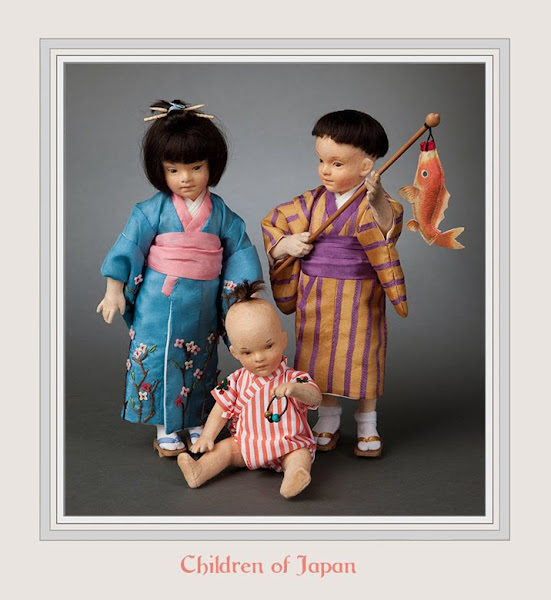

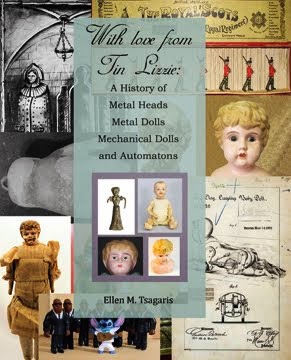
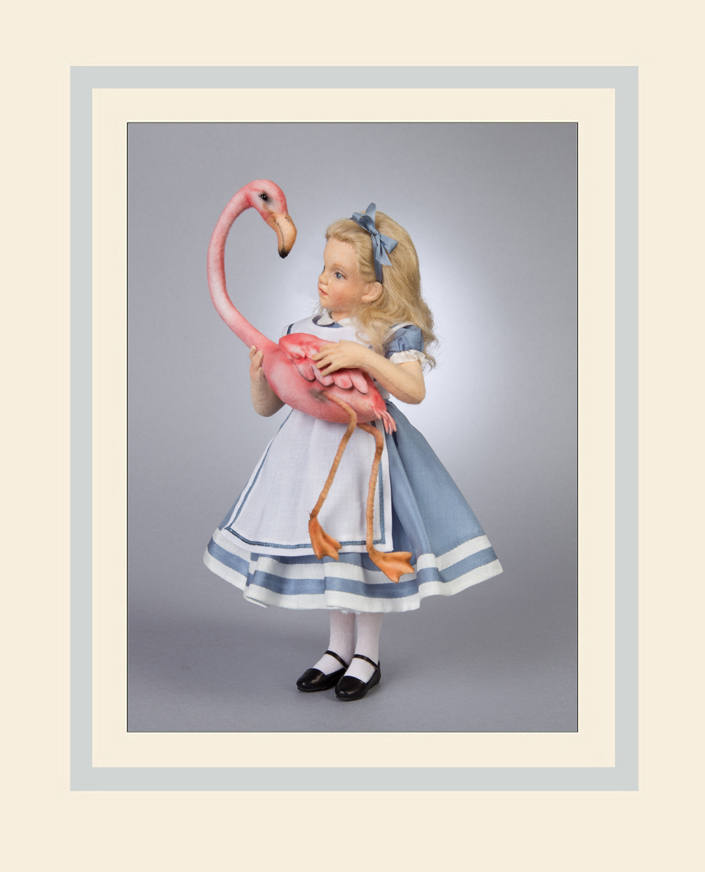


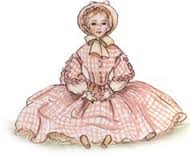


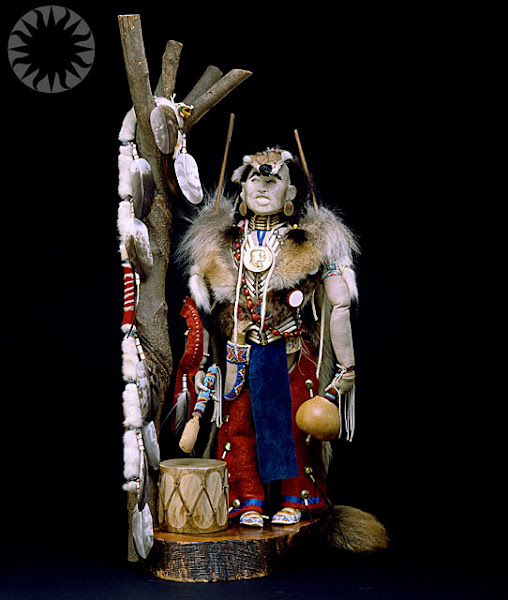
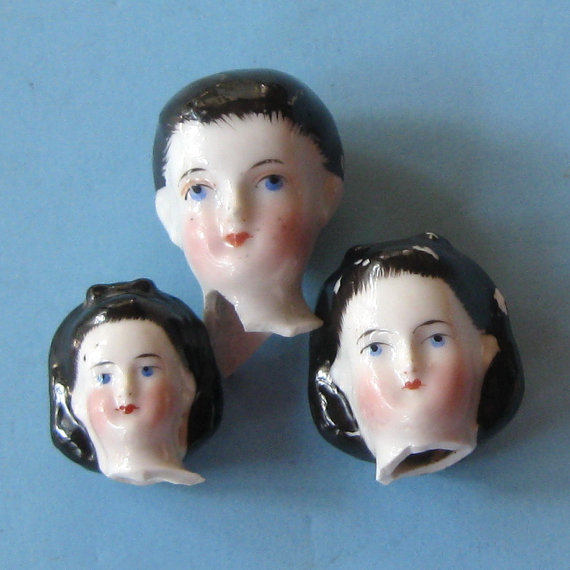
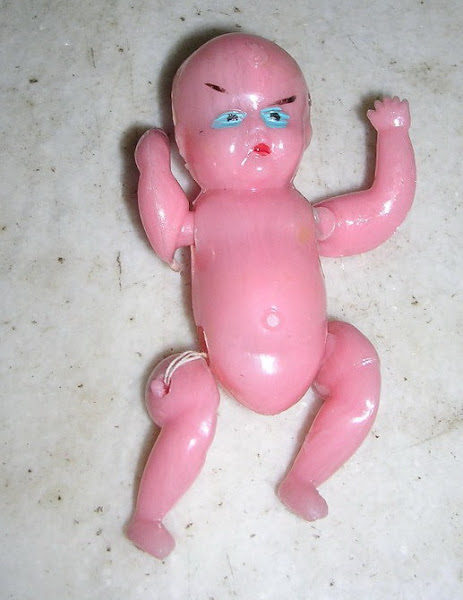
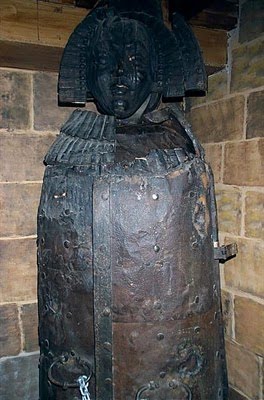

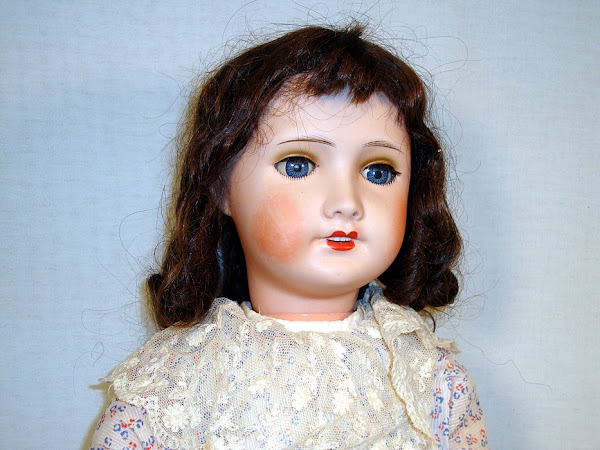



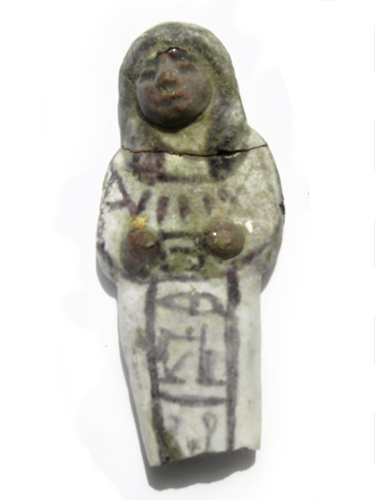
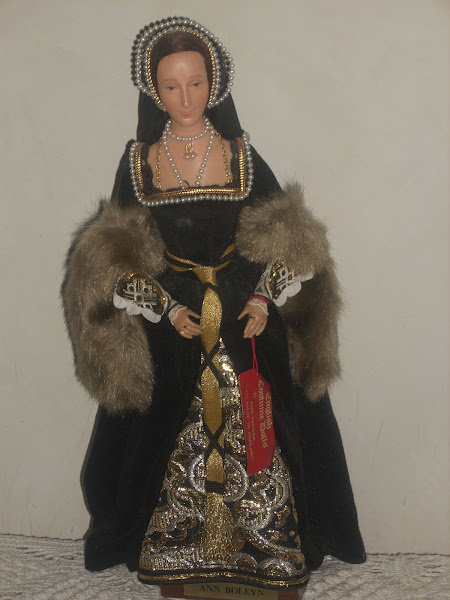





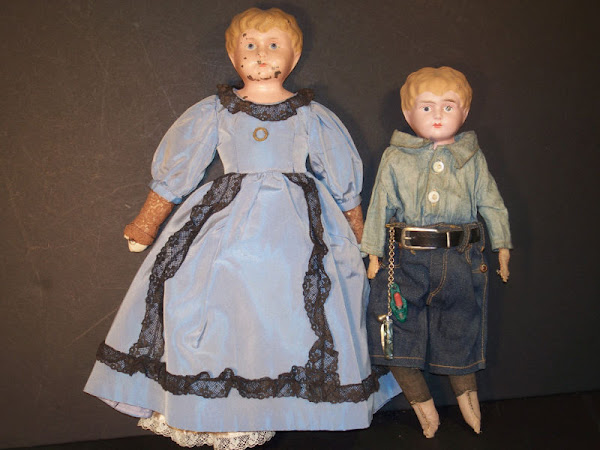


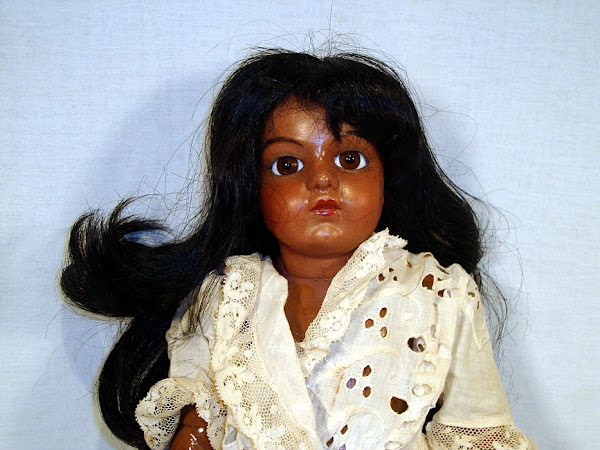
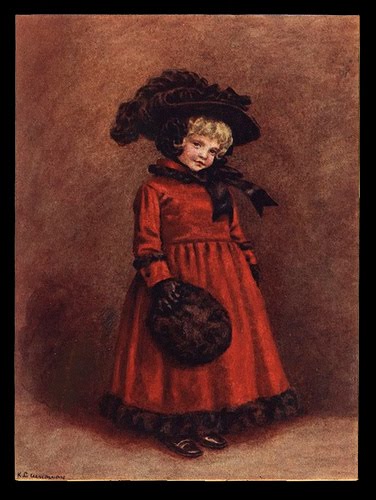

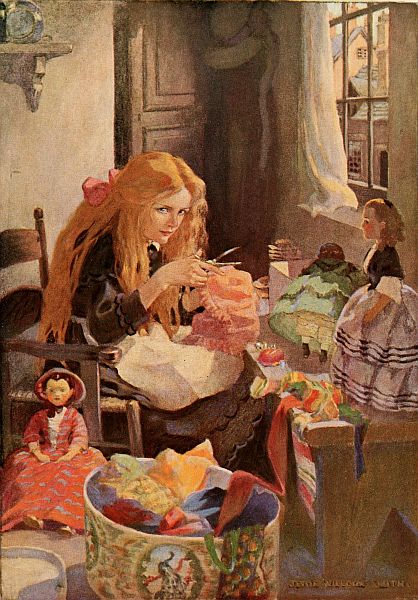


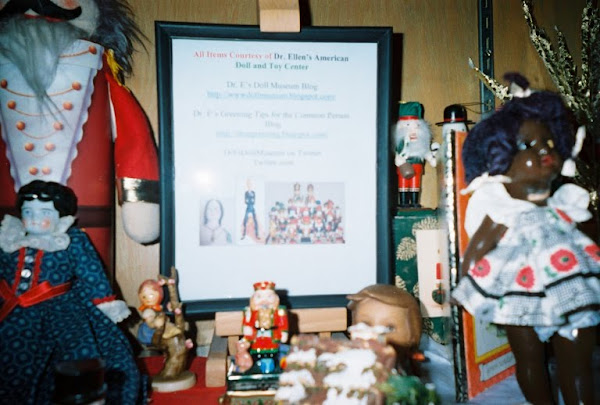






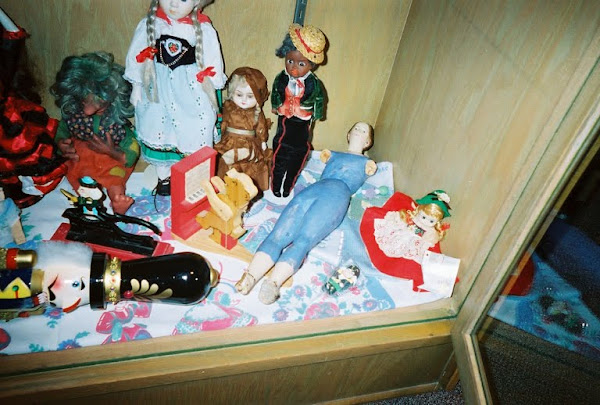
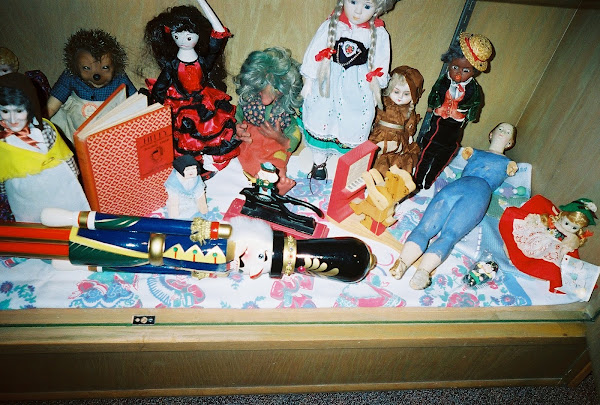
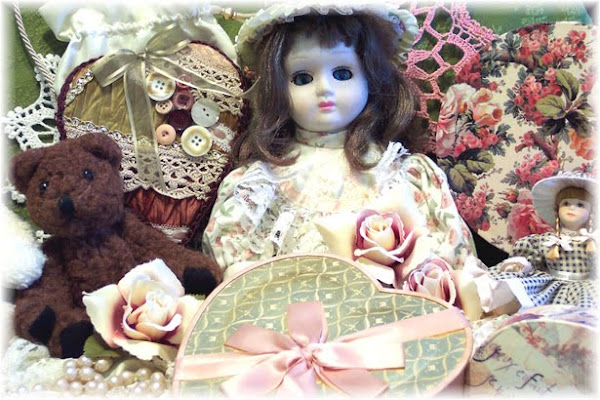
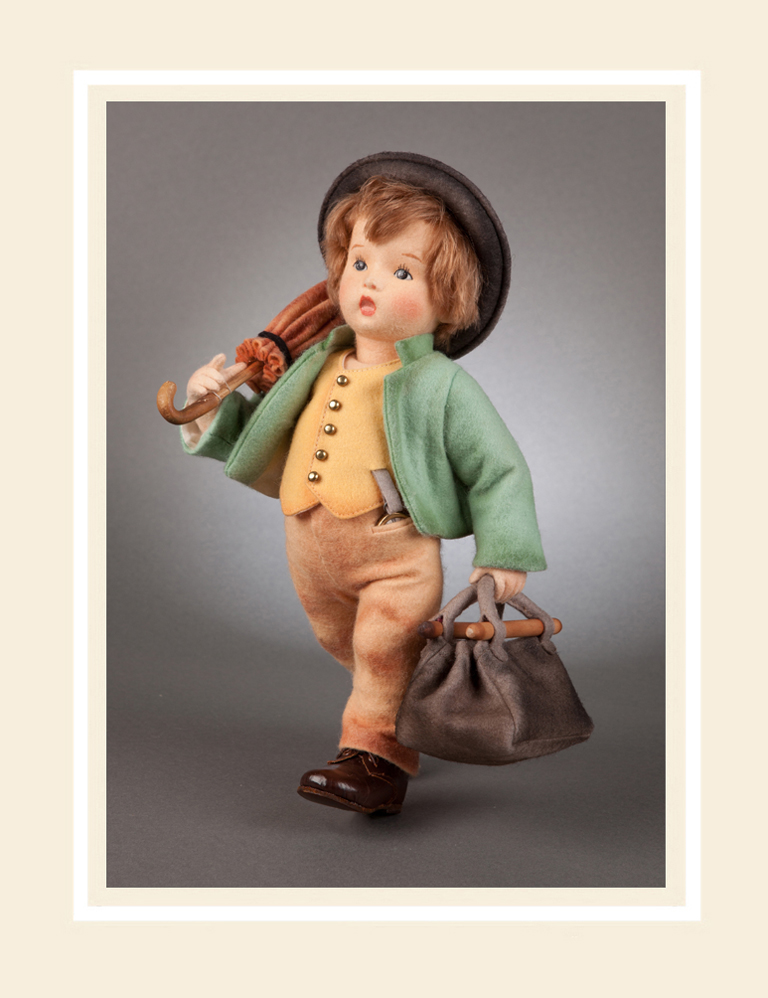

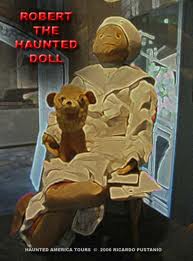

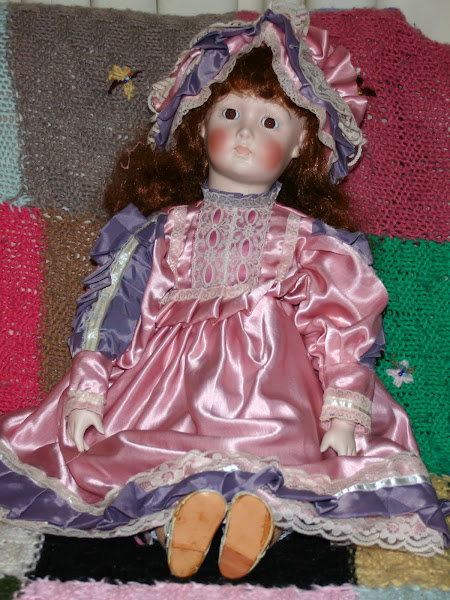
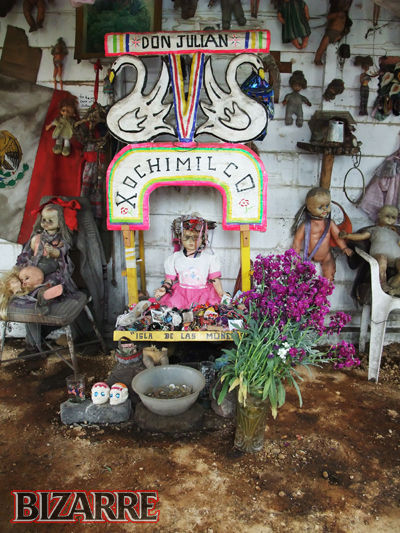
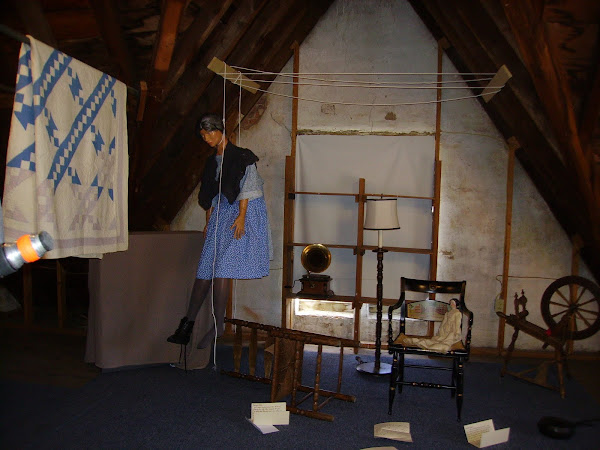
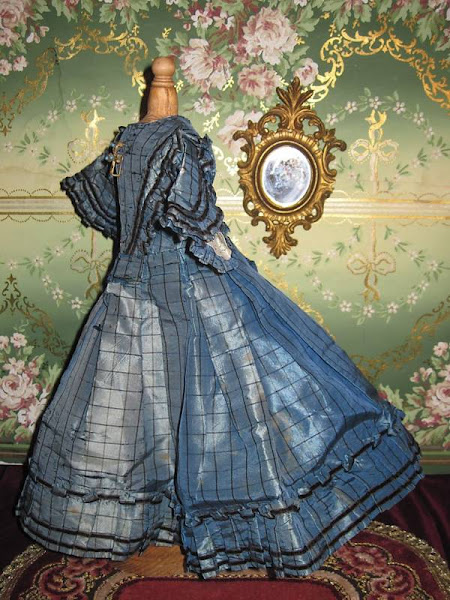wCWk~%24(KGrHqV,!h8Ew5GsnS3dBMUy3MzVPg~~_3.jpg)


